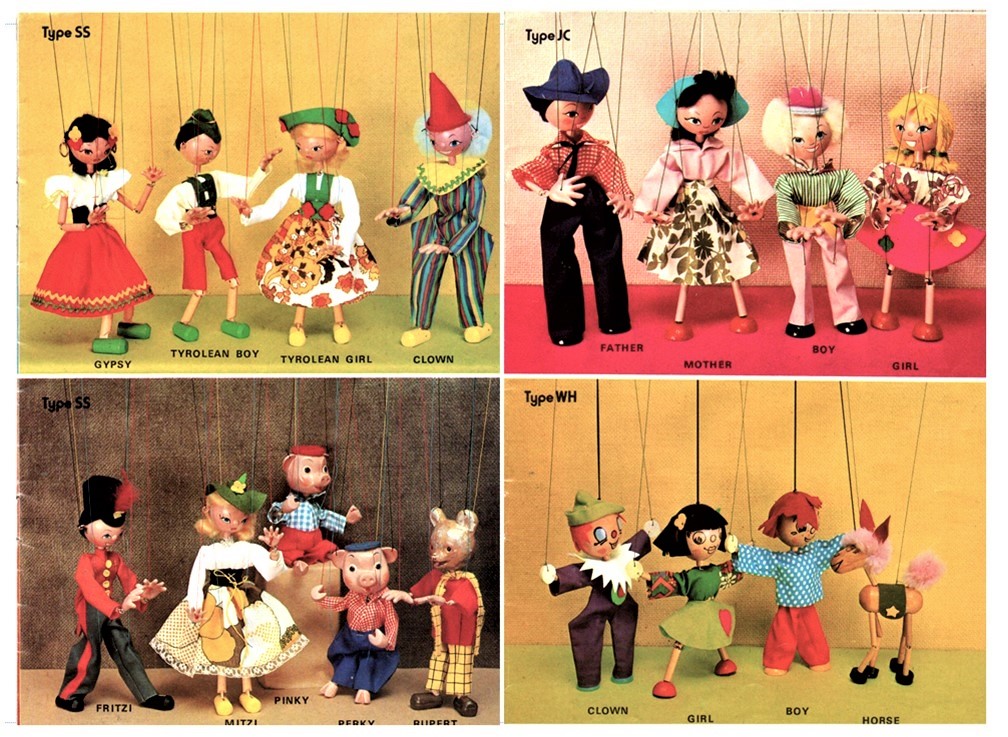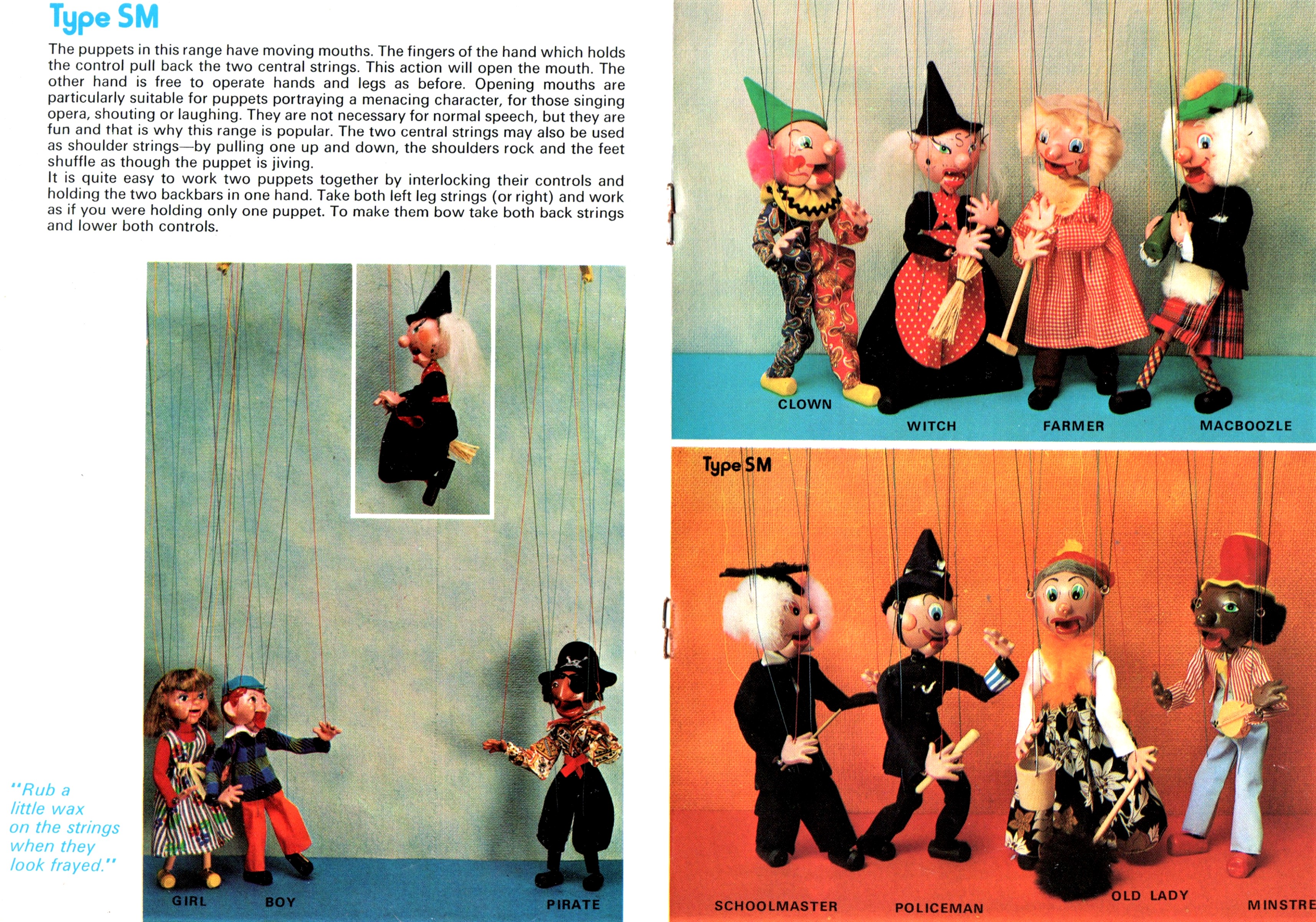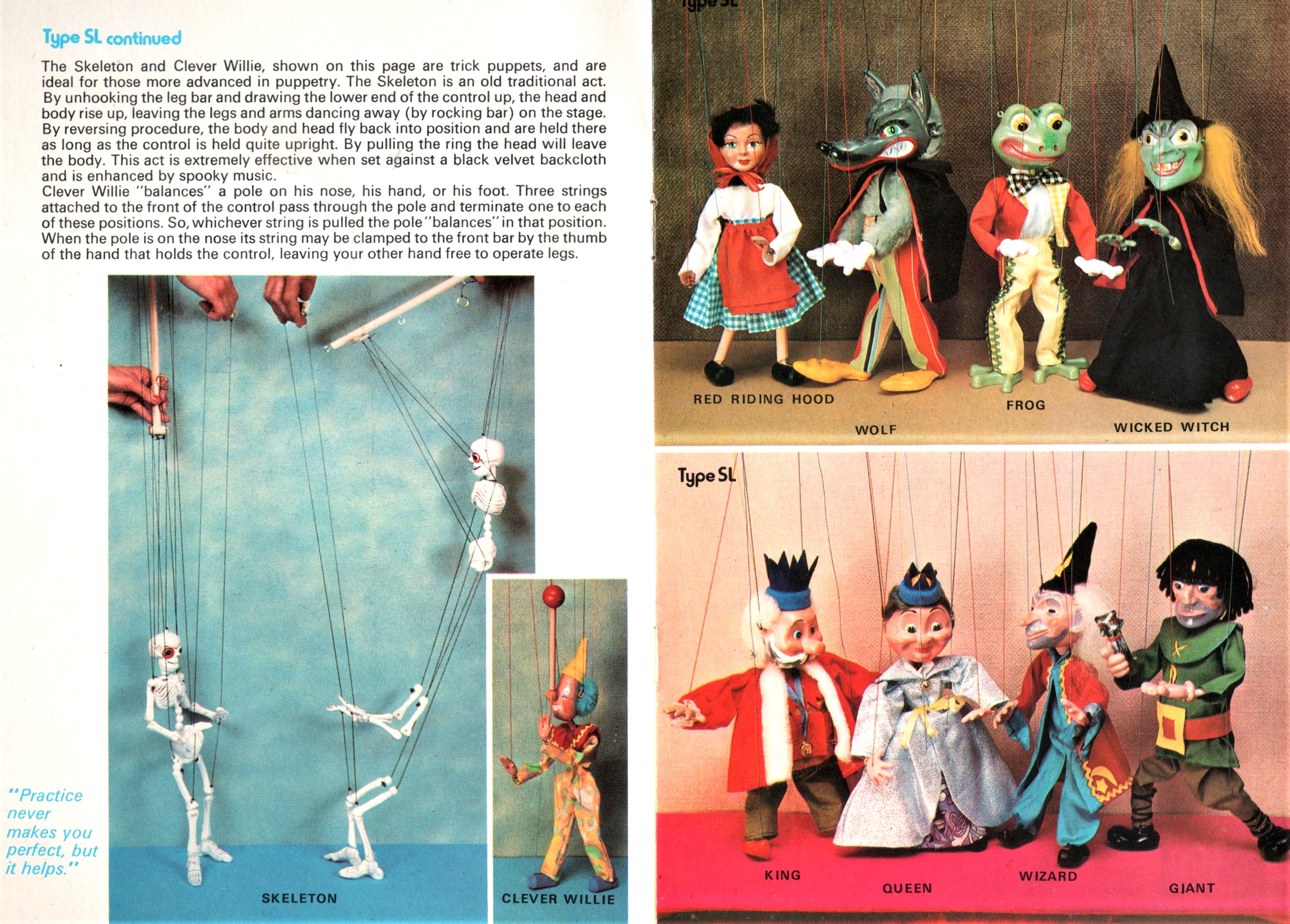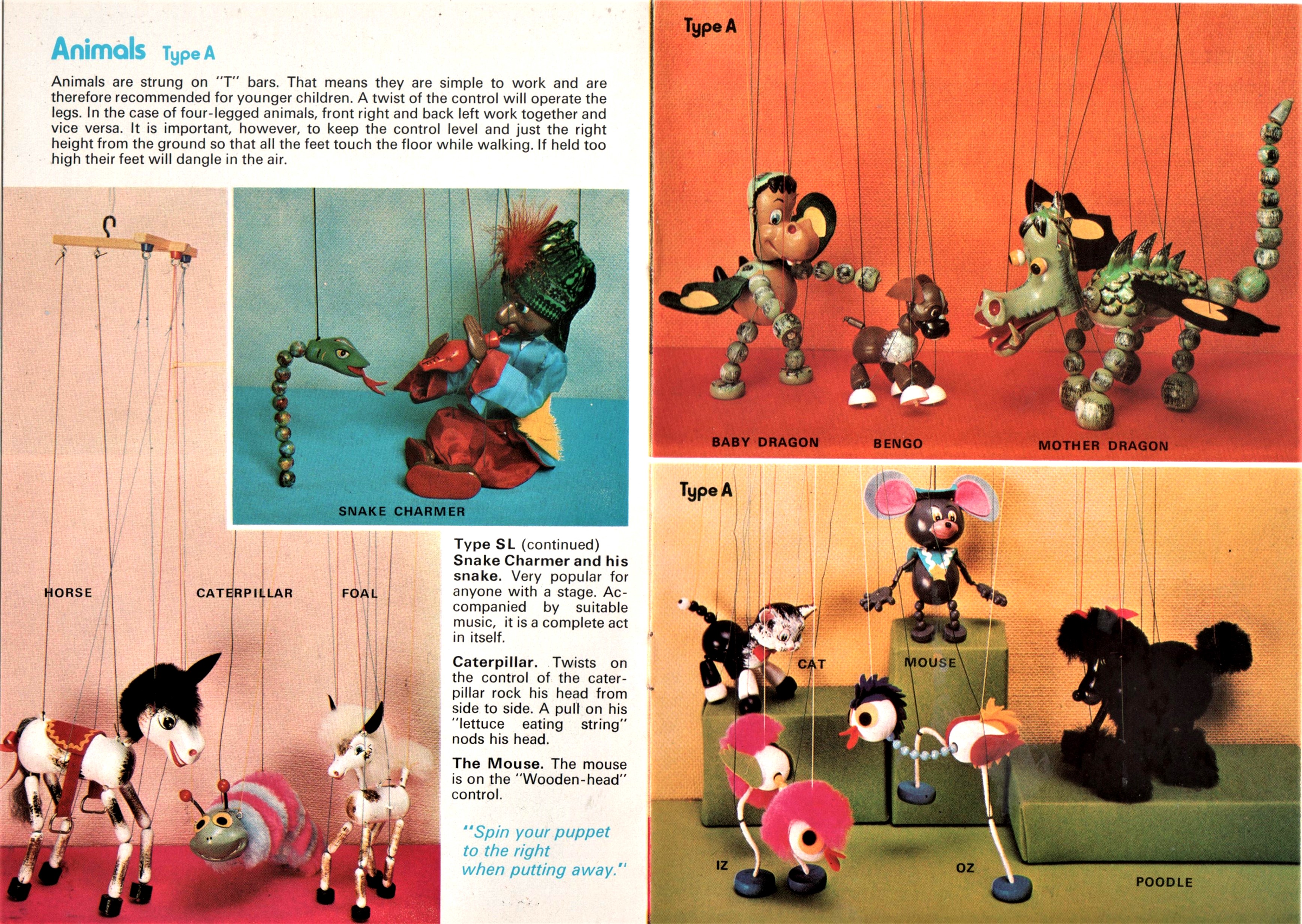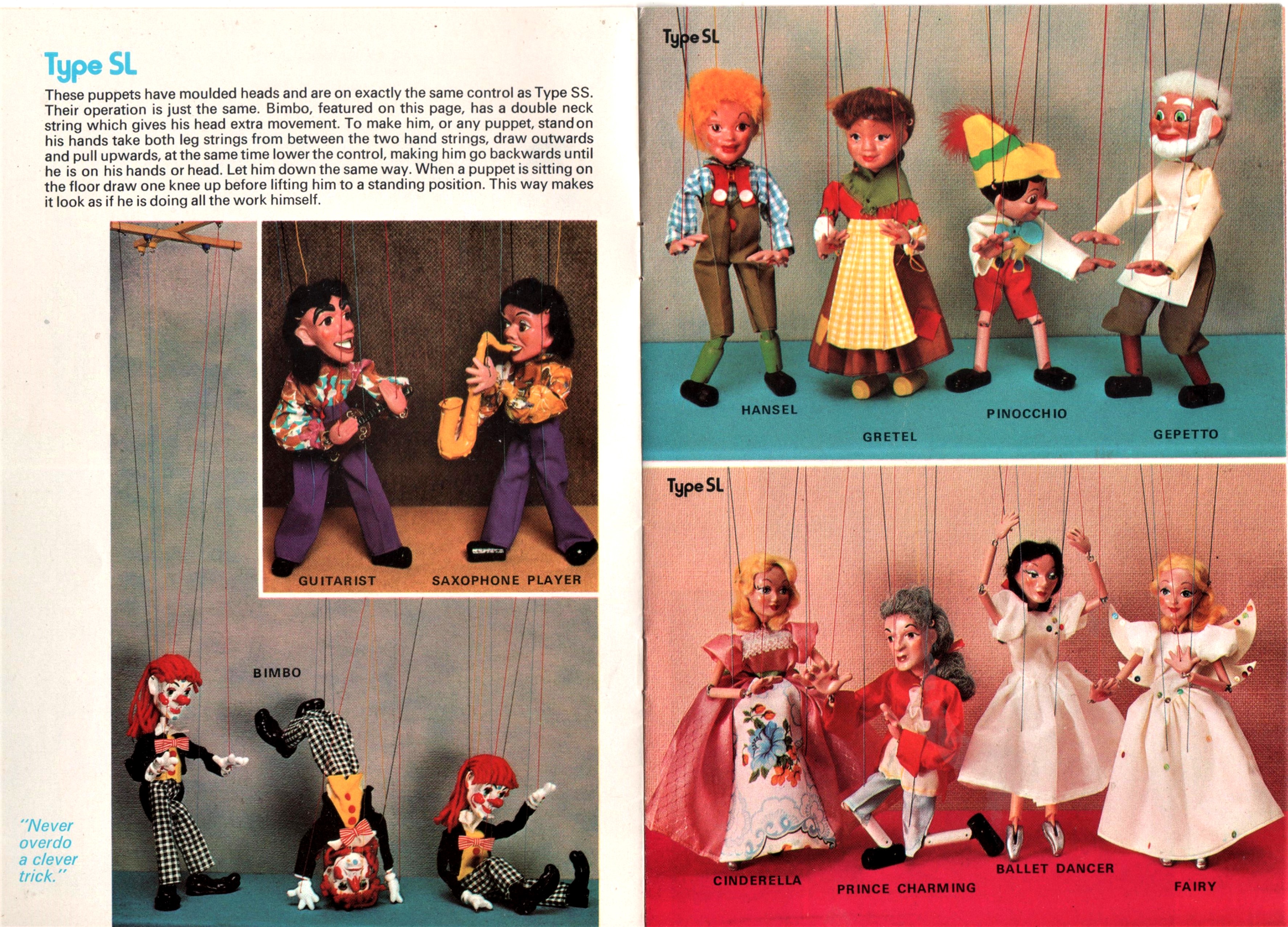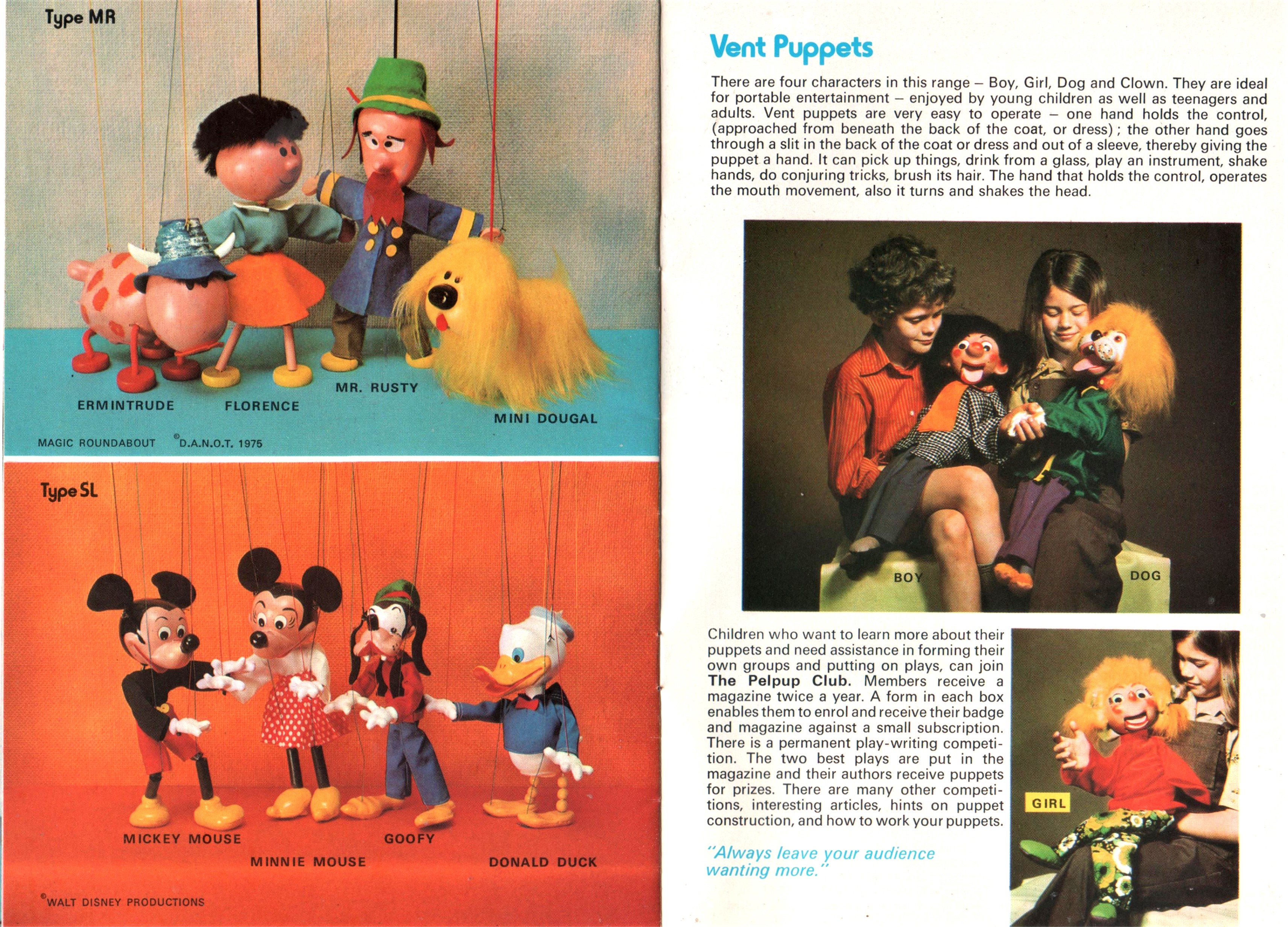“PELPOP” – The Story of Pelham Puppets – Part Two
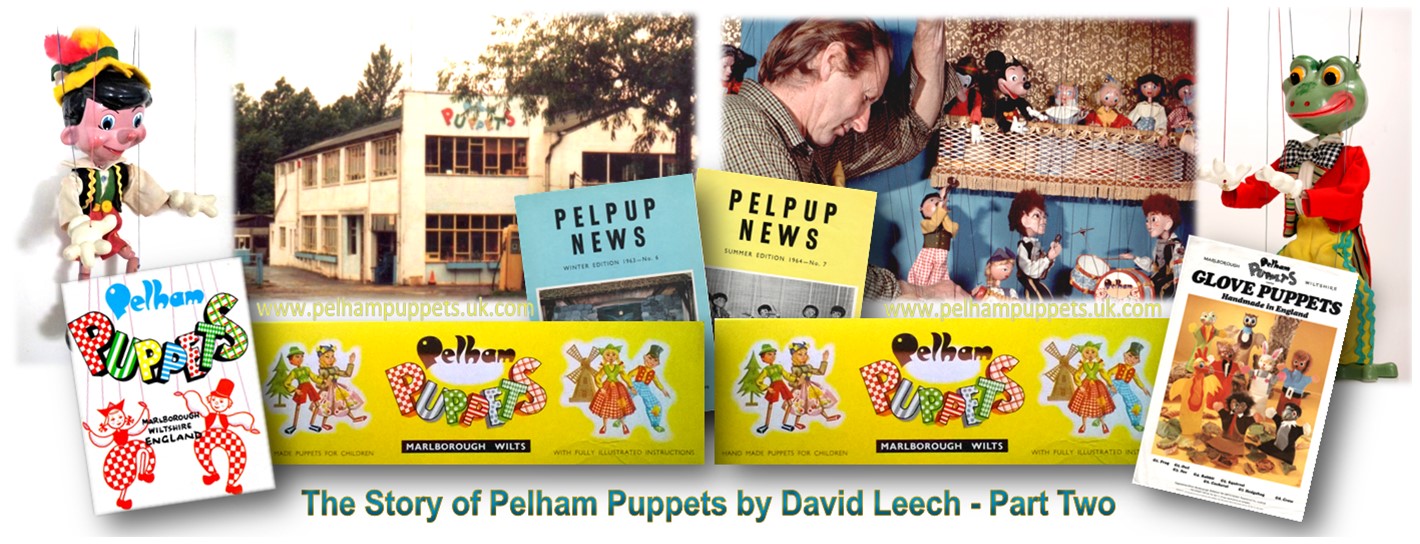
The 1950’s was certainly a decade of rapid expansion, ever increasing production, the future of the Company looked very bright. However, less than two years into the new decade, tragedy struck in October 1961.
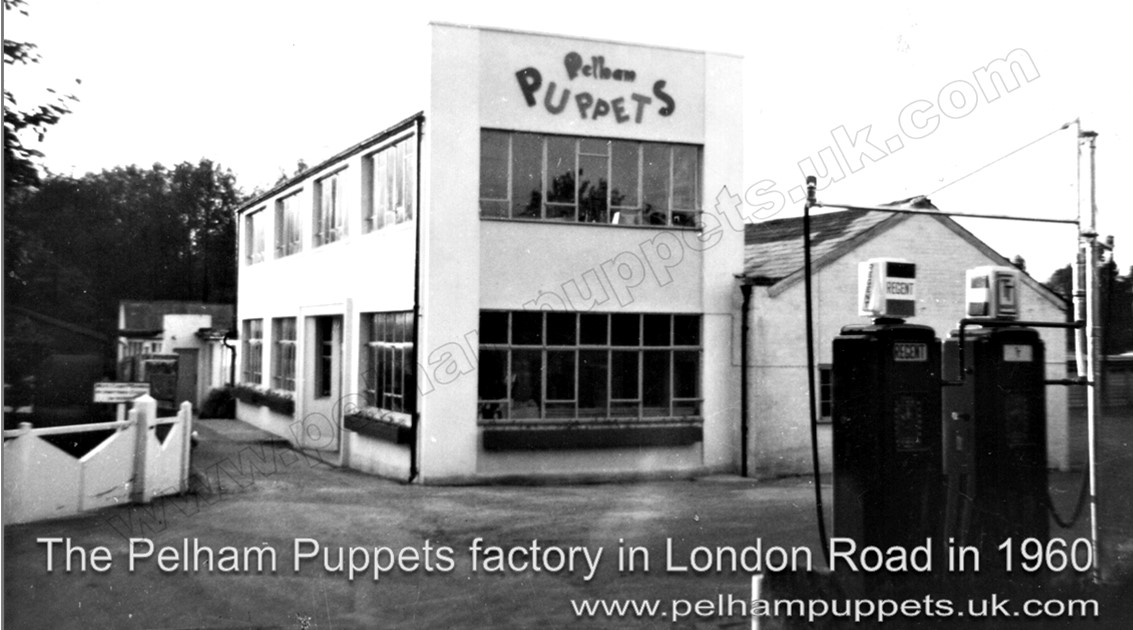
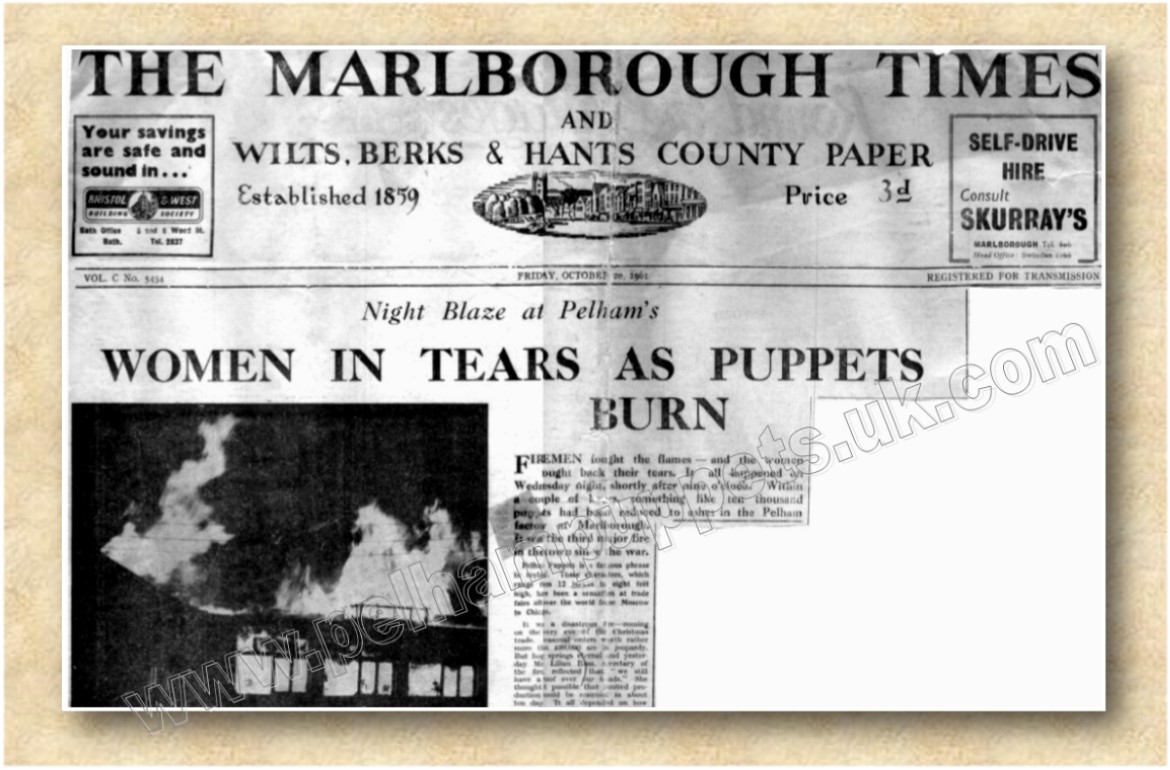 “Women in Tears as Puppets Burn” read the headline and “Firemen fought the flames and women fought back the tears.” reported the Marlborough Times. “It all happened on Wednesday night shortly after nine o’clock. Within a couple of hours something like ten thousand puppets had been reduced to ashes in the Pelham factory at Marlborough.”
“Women in Tears as Puppets Burn” read the headline and “Firemen fought the flames and women fought back the tears.” reported the Marlborough Times. “It all happened on Wednesday night shortly after nine o’clock. Within a couple of hours something like ten thousand puppets had been reduced to ashes in the Pelham factory at Marlborough.”
The first that anyone knew of the event was when Mr and Mrs Brookes who owned the Coal Yard next door to the factory looked out of their window about 10 o’clock that evening to see what they thought was a fireworks party! It appeared that there were rockets and other ‘whiz-bangs’ being set off in quick succession from the vicinity of the factory. It quickly dawned on them that there was something seriously wrong and that the factory was on fire!
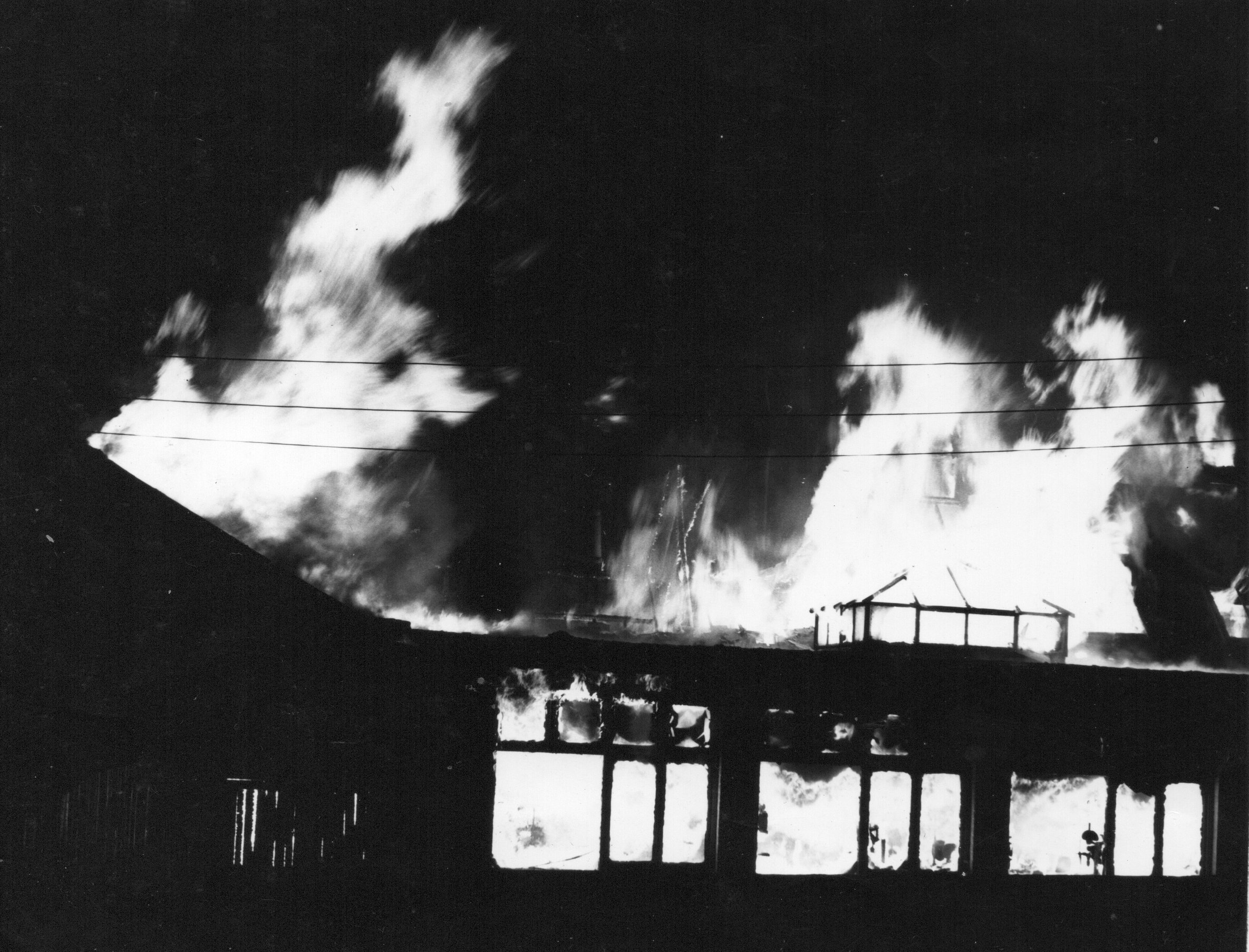 They immediately telephoned the fire brigade and then called Bob to tell him what was happening. Bob was thinking about going to bed but rapidly changed his mind! He telephoned Frank Lawton who lived a few hundred yards away in the same village, Ogbourne St Andrew. By the time he had done this, Anne, who was upstairs could see the red glow of the fire lighting up the sky in Marlborough about three miles away. The fire had obviously got a good hold by now and the concern was which part of the factory was actually on fire. Upon arriving at the scene Bob’s worse fears were confirmed, it was the paint shop that was ablaze in the centre of the factory. This explained the intensity of the heat and the rapid way in which it had spread. There was also the alarming sound of paint pots exploding periodically as the heat reached them. Each drum of paint that went up fed the flames to greater intensity and helped to spread the fire over the surrounding area.
They immediately telephoned the fire brigade and then called Bob to tell him what was happening. Bob was thinking about going to bed but rapidly changed his mind! He telephoned Frank Lawton who lived a few hundred yards away in the same village, Ogbourne St Andrew. By the time he had done this, Anne, who was upstairs could see the red glow of the fire lighting up the sky in Marlborough about three miles away. The fire had obviously got a good hold by now and the concern was which part of the factory was actually on fire. Upon arriving at the scene Bob’s worse fears were confirmed, it was the paint shop that was ablaze in the centre of the factory. This explained the intensity of the heat and the rapid way in which it had spread. There was also the alarming sound of paint pots exploding periodically as the heat reached them. Each drum of paint that went up fed the flames to greater intensity and helped to spread the fire over the surrounding area.
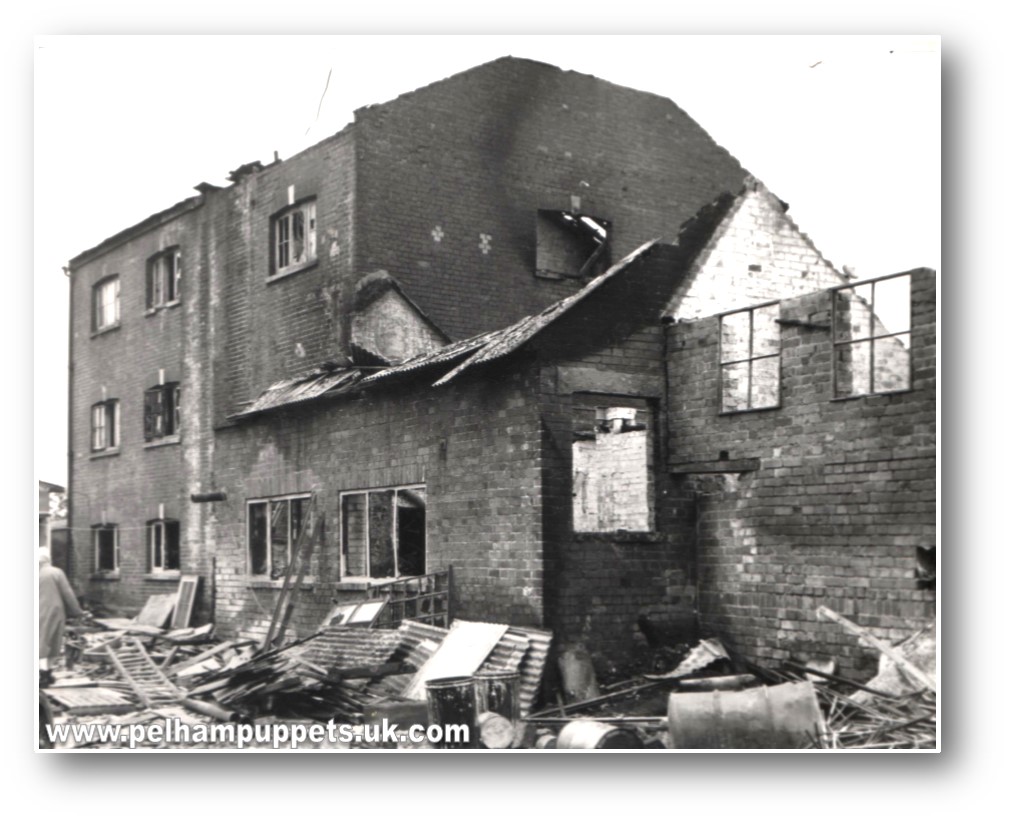 Characteristically, Bob turned his attention to the houses immediately across the road from the factory which were thatch covered and toward which the wind was blowing the flames and sparks. Leaving his own problems for the moment, Bob set about organising a party to keep the thatch of the roofs damped down. That done, he turned his attention back to his own problems which were becoming increasingly serious as every single minute passed. How much were they going to be able to save? Bob and Frank and a number of others immediately ran to the stock room which was piled high with completed goods. Frantically they began passing these out through the window to other willing hands who quickly formed a chain to move as much as possible out of reach of the flames. Bob was however, soon presented with another danger. The water being pumped into the upper floor was soaking through the ceiling above him and it was now beginning to collapse. Working against time, Bob and his helpers snatched what they could from the stock room but finally had to leave by order of the fire brigade.
Characteristically, Bob turned his attention to the houses immediately across the road from the factory which were thatch covered and toward which the wind was blowing the flames and sparks. Leaving his own problems for the moment, Bob set about organising a party to keep the thatch of the roofs damped down. That done, he turned his attention back to his own problems which were becoming increasingly serious as every single minute passed. How much were they going to be able to save? Bob and Frank and a number of others immediately ran to the stock room which was piled high with completed goods. Frantically they began passing these out through the window to other willing hands who quickly formed a chain to move as much as possible out of reach of the flames. Bob was however, soon presented with another danger. The water being pumped into the upper floor was soaking through the ceiling above him and it was now beginning to collapse. Working against time, Bob and his helpers snatched what they could from the stock room but finally had to leave by order of the fire brigade.
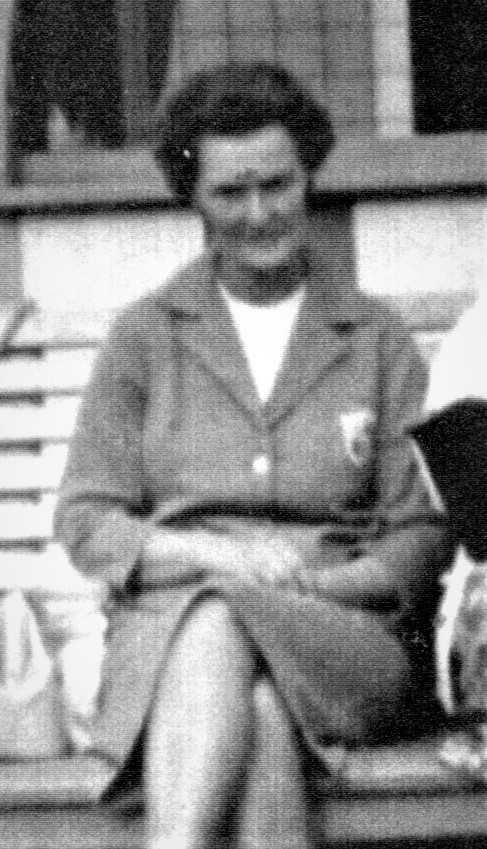 John and Ann Fraser were both employed at Pelham Puppets at the time of the fire. John worked in the maintenance workshop and Ann worked there for 17 years, mainly in the moulding room. Ann recalls, “I remember that night, John had been out with his friends and he came home later than expected and told us about the fire. He was absolutely black from head to foot with soot since he’d gone down to try and help out where he could. Before he left to come home that night Mr Pelham saw him and said, “John, you have ruined your best suit.” John told Mr Pelham not to worry about that since there was a lot of work to do in trying to save the stock and put the fire out. The next morning, Mr Pelham gave him some money to buy a new suit – I remember that!” John was over the moon! He was one of the best people I have ever worked for, he really was.
John and Ann Fraser were both employed at Pelham Puppets at the time of the fire. John worked in the maintenance workshop and Ann worked there for 17 years, mainly in the moulding room. Ann recalls, “I remember that night, John had been out with his friends and he came home later than expected and told us about the fire. He was absolutely black from head to foot with soot since he’d gone down to try and help out where he could. Before he left to come home that night Mr Pelham saw him and said, “John, you have ruined your best suit.” John told Mr Pelham not to worry about that since there was a lot of work to do in trying to save the stock and put the fire out. The next morning, Mr Pelham gave him some money to buy a new suit – I remember that!” John was over the moon! He was one of the best people I have ever worked for, he really was.

Anyway, the next morning, lots of people turned up to help with clearing things up. I remember there was still hose pipes lying all over the road and some buildings were still smouldering. We searched through the rubble trying to see what was good quality, and what wasn’t. We turned up at 7 o’clock in the morning and I didn’t go home until half past three the next morning! I remember Mr Pelham came over and he was rubbing his head, he’d been there all night I think, and he said, “Dear Annie, whatever happened here?” – I have never seen a man so broken as he was that morning. He was devastated.

Over the next three weeks I would go over to the house in Ogbourne ST Andrew, [Mr Pelham’s home,] in the evenings after working in Marlborough all day and work with Mrs Pelham. She had a little shed and I used to go over there and I used to paint Pinocchio shoes until about 8pm and at weekends. She would often ask if I could come over and help and my mum even came with me sometimes to help out as best she could as well. Mr Pelham was always very fair to me and I couldn’t have worked for a better person ever. He always used to call me Annie although everyone else called me Ann.”
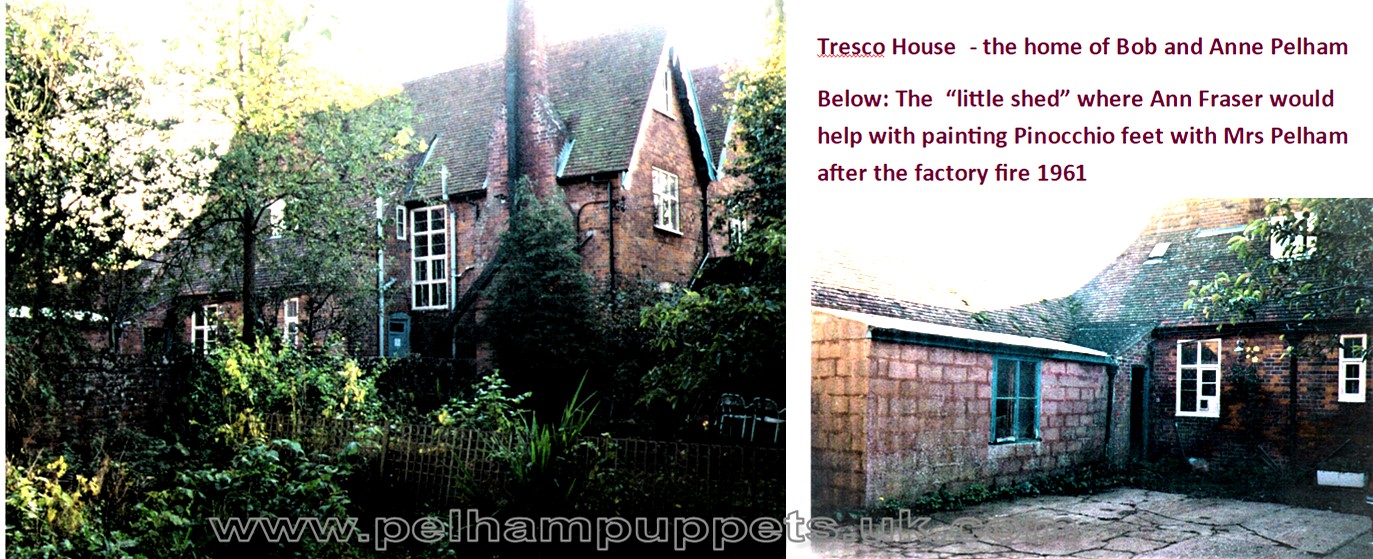
Several other employees tell a similar story of course since everyone “mucked in” to help clear up the mess. Even Anne Pelham told me how she, along with Bob and the employees became blackened as they spent the following day sifting through “the mud, the filth and the ashes.” They did manage to rescue a considerable quantity of completed puppets but the building was completely gutted. By daybreak Bob was able to look over the site and to his horror realised that the paint room where the fire had started and all the surrounding buildings, including the stock room, had all been completely destroyed. Only the blackened walls remained and these were unsafe and in imminent danger of collapse.
About the only place that remained intact were the factory offices in which were all the production records and files. It was therefore possible to pick up the threads of business, contact customers and try and obtain new, raw materials from the suppliers as quickly as possible. “It’s amazing,” recalled Bob, “to think that we moved everybody into six small store sheds and continued with production.” He was more than ready to recall the loyalty and good work of all his employees, “There was a good spirit throughout,” he was reported as saying in the Marlborough Times the following week. Although conjecture was rife for a time and everyone had their own pet theory, the actual cause was never established. That it started in the paint room was beyond doubt, but why, remains a mystery to this day.
A short time later plans for a new single-story factory had been drawn up and building work was well under way by the following year. It was an exciting period in the life of the company with a whole new range of puppets and a steady upward trend in sales both in the UK and abroad, especially America.
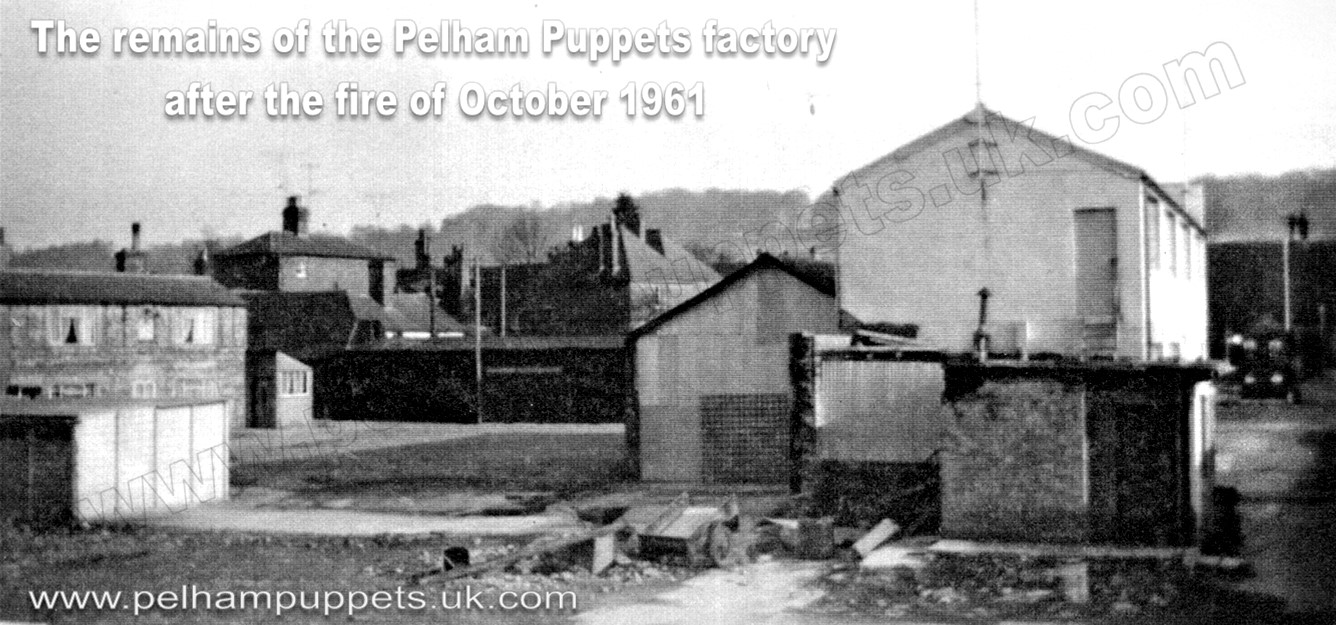
In a very short time, new, single story buildings were erected and puppet production was back to normal within six months. The photos below show some of the production rooms of the newly built factory in 1962.
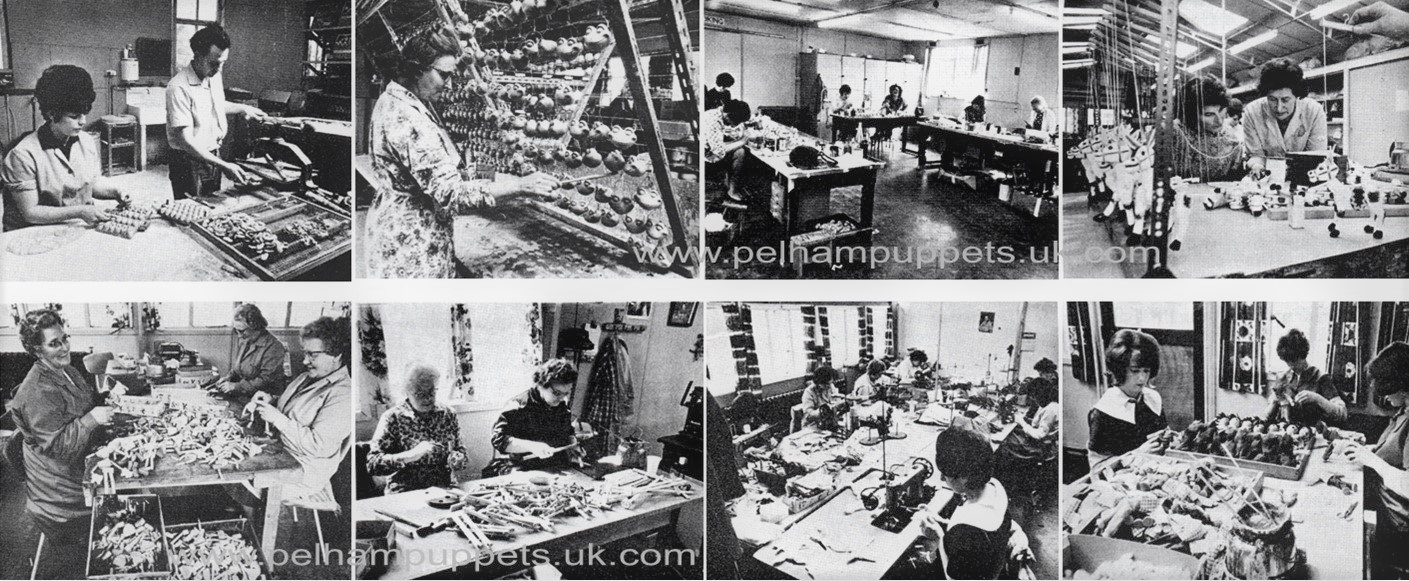
Rising from the Ashes – 1962 Onward.
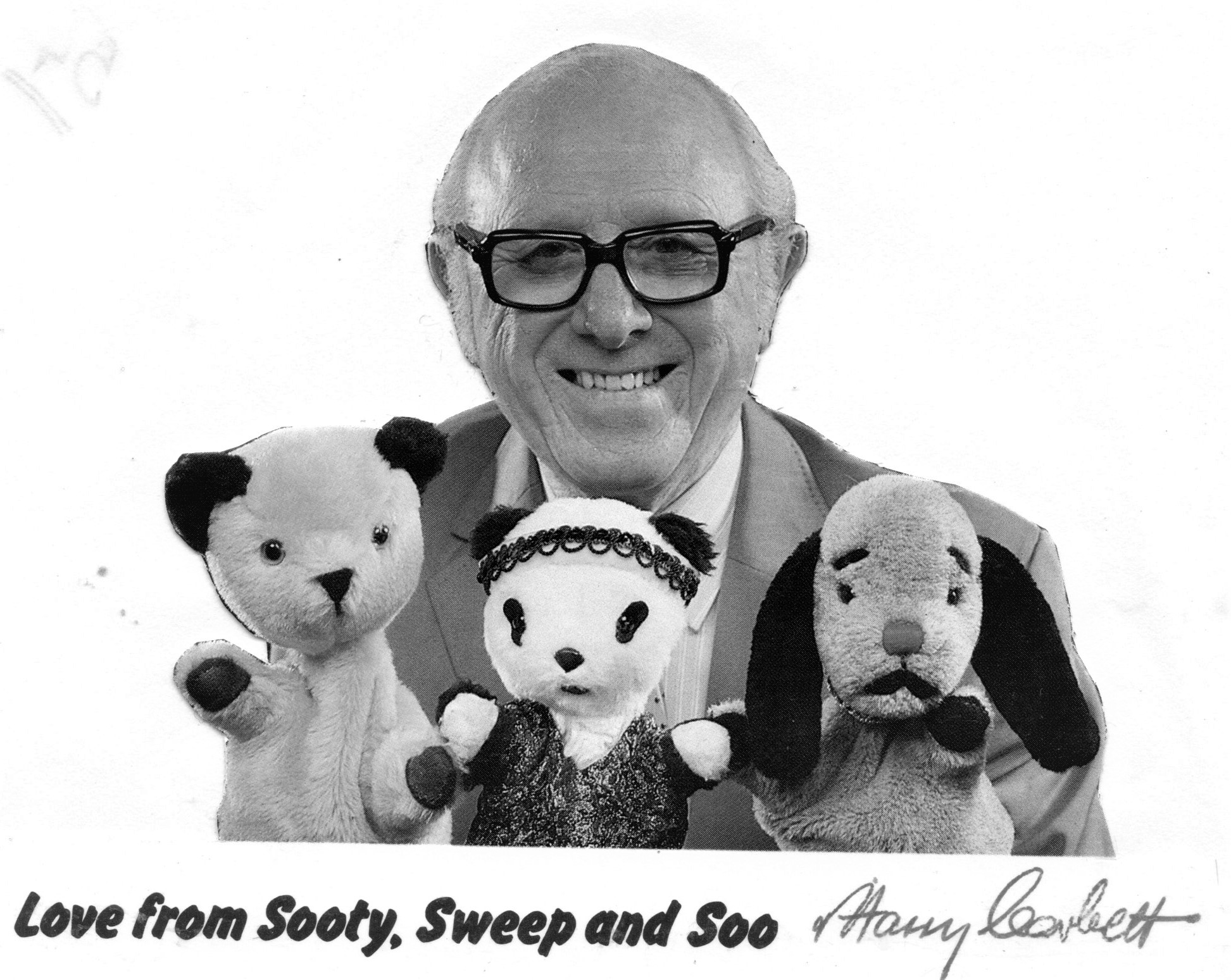
 On 22nd February 1962, Harry Corbett and his wife Marjorie along with his teddy-bear puppet, Sooty, paid a visit to the Pelham Puppet factory and the ‘Prime Minister of the Marionette World’ because they wanted some marionettes simple enough for Sooty to operate on his TV show. On his tour of the factory, Harry collected an assortment of puppets including Pinky and Perky, the singing, dancing television piglets that Bob had also put into production a few years before. The Sooty Show featuring the puppets was broadcast the following month. Harry wrote to the Czech creators of Pinky and Perky, Jan and Vlasta Dalibor, seeking permission to use the characters in his show, which they readily gave and the Sooty show featuring the Pinky and Perky Pelham Puppets that was broadcast from the BBC studios in Manchester in the following month. Harry Corbett enjoyed his visit to the Pelham factory except for one thing, explained Bob, “I expect Harry wished he had his arm in a sling because he was asked to sign his autograph for every girl in the factory!”
On 22nd February 1962, Harry Corbett and his wife Marjorie along with his teddy-bear puppet, Sooty, paid a visit to the Pelham Puppet factory and the ‘Prime Minister of the Marionette World’ because they wanted some marionettes simple enough for Sooty to operate on his TV show. On his tour of the factory, Harry collected an assortment of puppets including Pinky and Perky, the singing, dancing television piglets that Bob had also put into production a few years before. The Sooty Show featuring the puppets was broadcast the following month. Harry wrote to the Czech creators of Pinky and Perky, Jan and Vlasta Dalibor, seeking permission to use the characters in his show, which they readily gave and the Sooty show featuring the Pinky and Perky Pelham Puppets that was broadcast from the BBC studios in Manchester in the following month. Harry Corbett enjoyed his visit to the Pelham factory except for one thing, explained Bob, “I expect Harry wished he had his arm in a sling because he was asked to sign his autograph for every girl in the factory!”
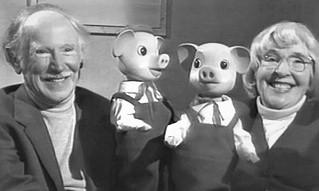 Bob had previously arranged for Jan and Vlasta Dalibor to visit the factory to obtain first-hand information about Pinky and Perky. These two little piglets with their speeded-up voices, first appeared on BBC TV in 1957. Unlike some of the other TV characters produced under licence by the company, the Pinky and Perky Pelham Puppets proved remarkably popular and remained in production until 1985.
Bob had previously arranged for Jan and Vlasta Dalibor to visit the factory to obtain first-hand information about Pinky and Perky. These two little piglets with their speeded-up voices, first appeared on BBC TV in 1957. Unlike some of the other TV characters produced under licence by the company, the Pinky and Perky Pelham Puppets proved remarkably popular and remained in production until 1985.
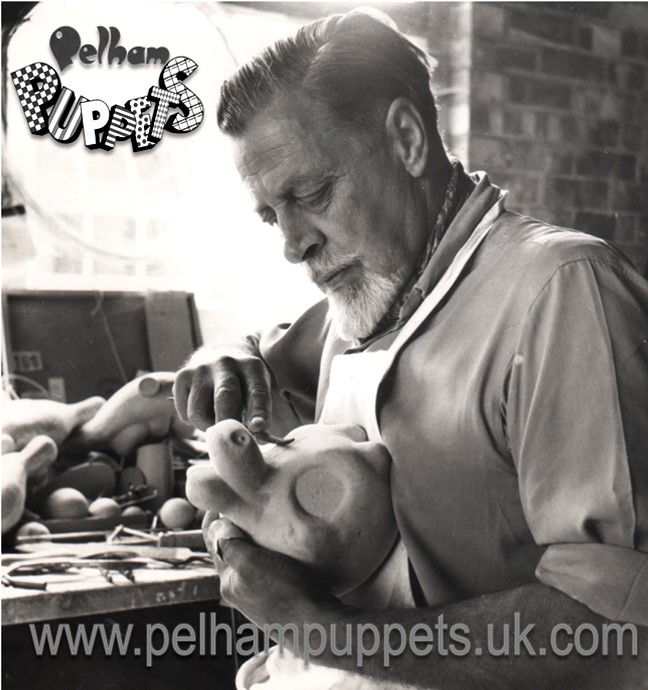 In 1963, over 226, 200 puppets were produced making it a record year for the number of puppets made and included a whole new range of characters designed by Peter Carter-Page. He was a respected Canadian artist who had previously worked for the Walt Disney Studios. He had been living in Toronto, Canada, before coming to England and obtained work making puppets for Jan Bussell and later began to work for Bob Pelham. More information can be found HERE.
In 1963, over 226, 200 puppets were produced making it a record year for the number of puppets made and included a whole new range of characters designed by Peter Carter-Page. He was a respected Canadian artist who had previously worked for the Walt Disney Studios. He had been living in Toronto, Canada, before coming to England and obtained work making puppets for Jan Bussell and later began to work for Bob Pelham. More information can be found HERE.
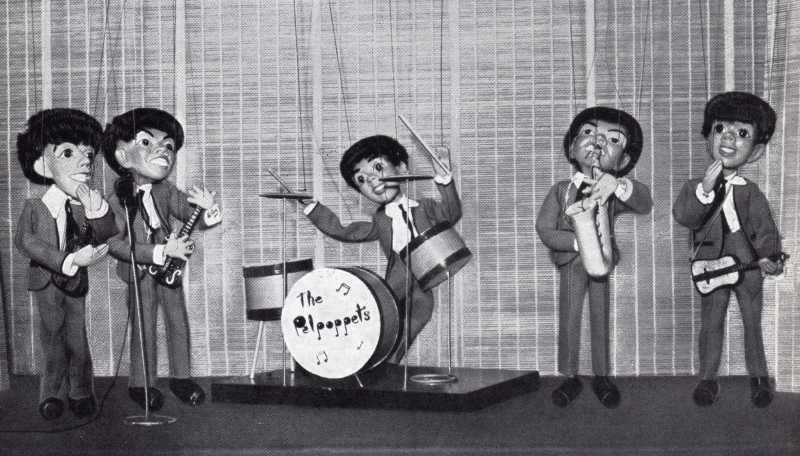 Always on the lookout for new ideas, Bob realised the fun and potential that a puppet pop group could provide. Noting the success of the Pinky and Perky TV programmes and the popularity of the music which came to dominate their shows, particularly with a group of puppets called the ‘Beakles’ which as their name implied, consisted of a ‘fab four’ with huge beak faces, Bob came up with a pop group of his own which he called the Pelpoppets that he featured in Pelpup News and wrote: “They are not meant to look like any one particular group, they are just present-day types that can be grouped together as you please.”
Always on the lookout for new ideas, Bob realised the fun and potential that a puppet pop group could provide. Noting the success of the Pinky and Perky TV programmes and the popularity of the music which came to dominate their shows, particularly with a group of puppets called the ‘Beakles’ which as their name implied, consisted of a ‘fab four’ with huge beak faces, Bob came up with a pop group of his own which he called the Pelpoppets that he featured in Pelpup News and wrote: “They are not meant to look like any one particular group, they are just present-day types that can be grouped together as you please.”
The range of characters continued to increase, partly due to television programmes featuring puppets. Through the medium of television, they became loved and wanted by increasing numbers of children. Where the aerials went up so did the sales. Once the production rights were obtained to produce certain characters, Pelham was almost certain of success. Puppet characters from TV programmes such as Pinky & Perky, Hannah Barbera Cartoons, The Magic Roundabout, the Wombles and later the Muppets, were all produced in the 1960s through to the end of the 1970s.

Above: (Left to right) Tex Tucker; Mike Mercury; Steve Zodiac and Venus.

Above: (Left to right) Pinky & Perky, Huckleberry Hound & Yogi Bear, Magic Roundabout characters
However, in 1965, a very unfortunate thing occurred. There was an alarming drop in sales. It turned out to be a very depressing year and some large cuts had to be made. Weekly production fell to a low of eight hundred puppets a week and annual production for the year was less than 132,000 compared to the previous year of over 200,000. The first indication of trouble came from the American agent who revealed that Japanese manufacturers who had always supplied the American toy market with large quantities of other toys had copied Pelham Puppets and were flooding the American market with theirs! It wasn’t long before these cheap copies were making their way into toy shops in Britain. However, such copies and imitations that did appear were always of inferior quality, usually lacking in character and not so easy to operate. The public came to appreciate that the quality of Pelham Puppets was worth paying for.
 Above: 4-page sales leaflet depicting the reduced range of characters produced two years earlier and the introduction of the Type SM Boy and Girl. The type SM Girl had bare feet just like UK pop singer, Sandie Shaw used to do when she sang on stage.
Above: 4-page sales leaflet depicting the reduced range of characters produced two years earlier and the introduction of the Type SM Boy and Girl. The type SM Girl had bare feet just like UK pop singer, Sandie Shaw used to do when she sang on stage.
By the end of the decade, the company was ready to step out of the depression into a period of steady expansion and the recovery from the disastrous fire and invasion of inferior copies was now well under way.
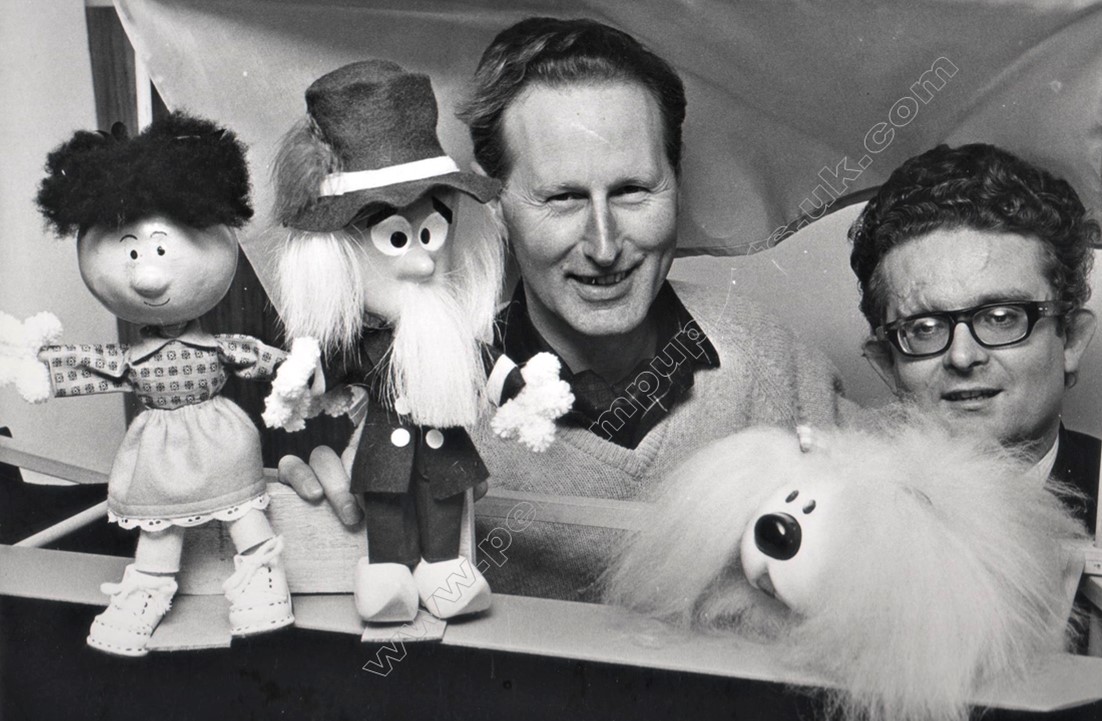 Bob still managed to keep an eye on children’s television programmes and in 1965, The Magic Roundabout, created by Frenchman Serge Danot was first shown. Since rod puppets were used 90% more often in the amateur and professional shows in European countries than marionettes, Bob branched out into this style of puppet with the Magic Roundabout characters, producing rather large rod puppets of Mr Rusty, Florence, Zebedee and Florence. M Serge Danot visited the factory early in 1967 and was very impressed with what he saw and was confident that Bob would do a very good job of producing the puppet characters.
Bob still managed to keep an eye on children’s television programmes and in 1965, The Magic Roundabout, created by Frenchman Serge Danot was first shown. Since rod puppets were used 90% more often in the amateur and professional shows in European countries than marionettes, Bob branched out into this style of puppet with the Magic Roundabout characters, producing rather large rod puppets of Mr Rusty, Florence, Zebedee and Florence. M Serge Danot visited the factory early in 1967 and was very impressed with what he saw and was confident that Bob would do a very good job of producing the puppet characters.
Glove puppets of Dougal, Florence and Mr Rusty, followed as did Junior Range string puppets of Florence, Mr Rusty, Ermintrude and a one string ‘mini’ Dougal. In addition, Bob introduced a Mrs Dougal with natural, long black sheepskin hair from Scandinavia in 1967 and could only be bought from Hamleys and Harrods in London.

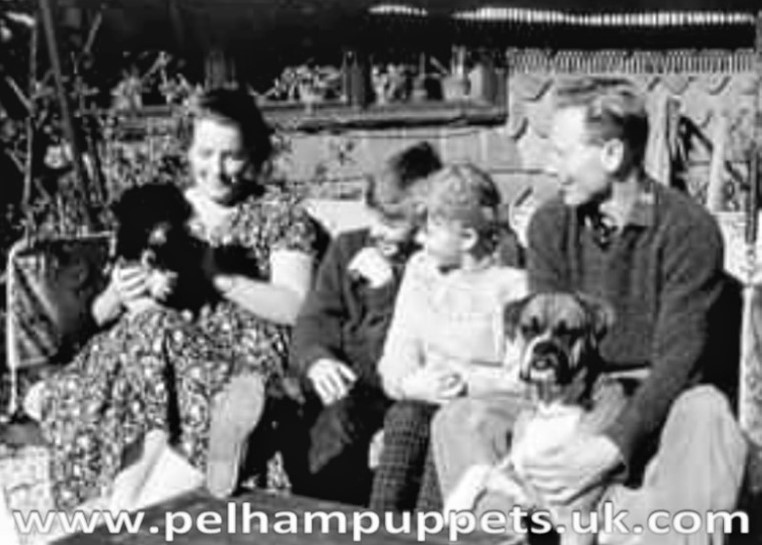 Bob related how Serge Danot had been amazed at how large the puppet factory was. “I think he thought I was one man with a dog!” chuckled Bob, since Dougal, one of the most popular characters in the programme was based on a breed of dog called Shih Tzu, (pronounced Sheed Zoo) and Bob actually owned one! A black one with white paws and chest, who served to inspire the creation of the Mrs Dougal puppet, “It’s comical to see him scuttle about and twist round just like Dougal does on TV,” (The family photo shows Anne Pelham with their Shih Tzu around 1966.)
Bob related how Serge Danot had been amazed at how large the puppet factory was. “I think he thought I was one man with a dog!” chuckled Bob, since Dougal, one of the most popular characters in the programme was based on a breed of dog called Shih Tzu, (pronounced Sheed Zoo) and Bob actually owned one! A black one with white paws and chest, who served to inspire the creation of the Mrs Dougal puppet, “It’s comical to see him scuttle about and twist round just like Dougal does on TV,” (The family photo shows Anne Pelham with their Shih Tzu around 1966.)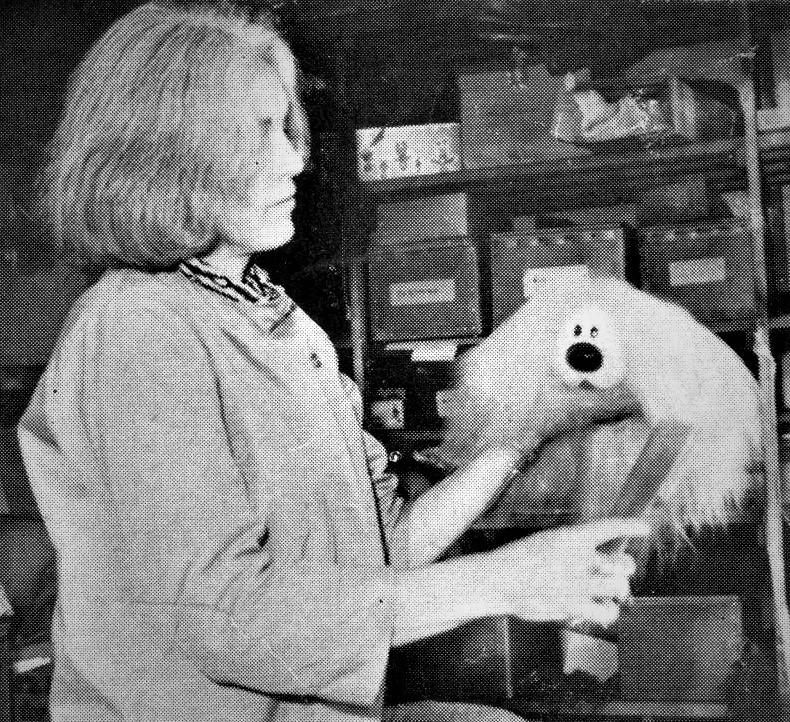
Indeed, 1967 proved to be what Bob called ‘The Year of the Dougal’ since the demand for Dougal puppets especially was so great and a separate department was set up in the factory to make them. Nearly 2,000 were produced every week until Christmas and they were being bought up as soon as they were put on the shelves.
The Ventriloquial Puppets 1968
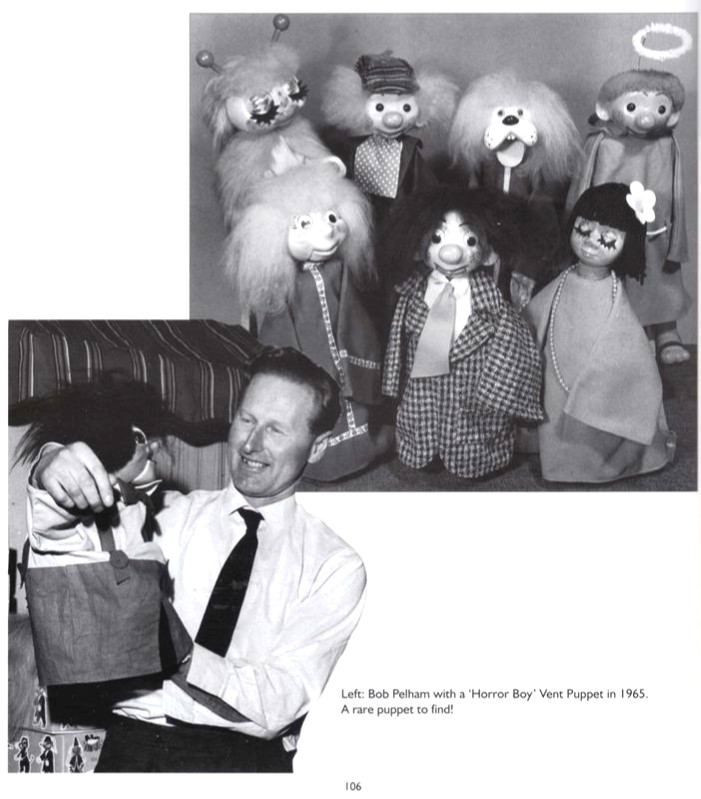 Bob had been working towards promoting a greater interest in puppetry from older children and grown-ups and so came up with a new range of puppets in 1968 that were designed to encourage older age groups to become involved. These were his ‘Ventriloquial Puppets’ (vent puppets for short) with large heads with flexible head movement and moving mouths. “The novelty of these new puppets is that you put your free hand through the sleeve of the jacket and the puppet now has a hand of its own,” said Bob, and “The scope they offer appeals to older children and yet their simplicity enables younger children to handle them with ease.” Within the first year, a range of seven characters, comprising of Supy, the boy with long black, sheepskin hair, Cornelia with large moving eyes and lashes, Boggles, a girl with blonde/yellow sheepskin hair, a Monk with halo attached, Katie the caterpillar also with large eyes and lashes and finally, Walter wearing the deer-stalker hat and Fido the singing dog. They became remarkably successful in the United States and consignments of five thousand at a time were exported every few weeks and, according to Bob, “Were responsible for putting our export figures up by 50% over the year.” From September 1974, legs were added to these puppets and this, in turn led to the production of 24-inch-tall string puppets in the late 70s. The upward trend continued with about one hundred thousand puppets finding their way each year, to the United States alone.
Bob had been working towards promoting a greater interest in puppetry from older children and grown-ups and so came up with a new range of puppets in 1968 that were designed to encourage older age groups to become involved. These were his ‘Ventriloquial Puppets’ (vent puppets for short) with large heads with flexible head movement and moving mouths. “The novelty of these new puppets is that you put your free hand through the sleeve of the jacket and the puppet now has a hand of its own,” said Bob, and “The scope they offer appeals to older children and yet their simplicity enables younger children to handle them with ease.” Within the first year, a range of seven characters, comprising of Supy, the boy with long black, sheepskin hair, Cornelia with large moving eyes and lashes, Boggles, a girl with blonde/yellow sheepskin hair, a Monk with halo attached, Katie the caterpillar also with large eyes and lashes and finally, Walter wearing the deer-stalker hat and Fido the singing dog. They became remarkably successful in the United States and consignments of five thousand at a time were exported every few weeks and, according to Bob, “Were responsible for putting our export figures up by 50% over the year.” From September 1974, legs were added to these puppets and this, in turn led to the production of 24-inch-tall string puppets in the late 70s. The upward trend continued with about one hundred thousand puppets finding their way each year, to the United States alone.
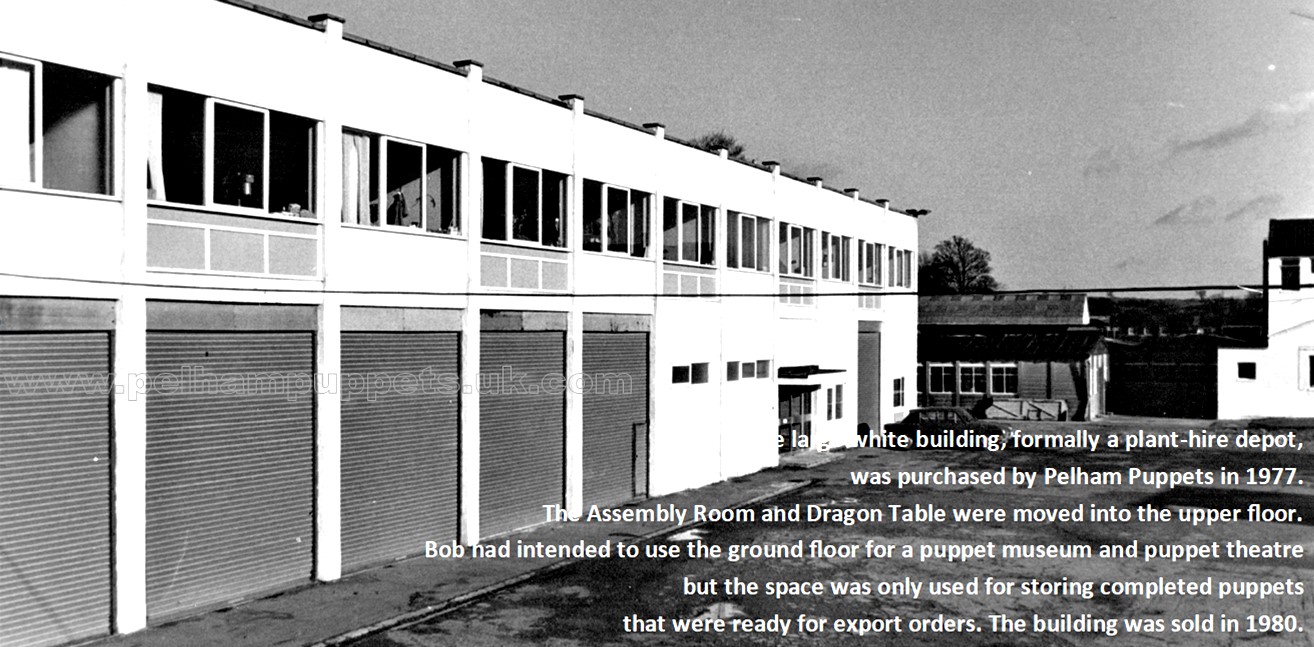
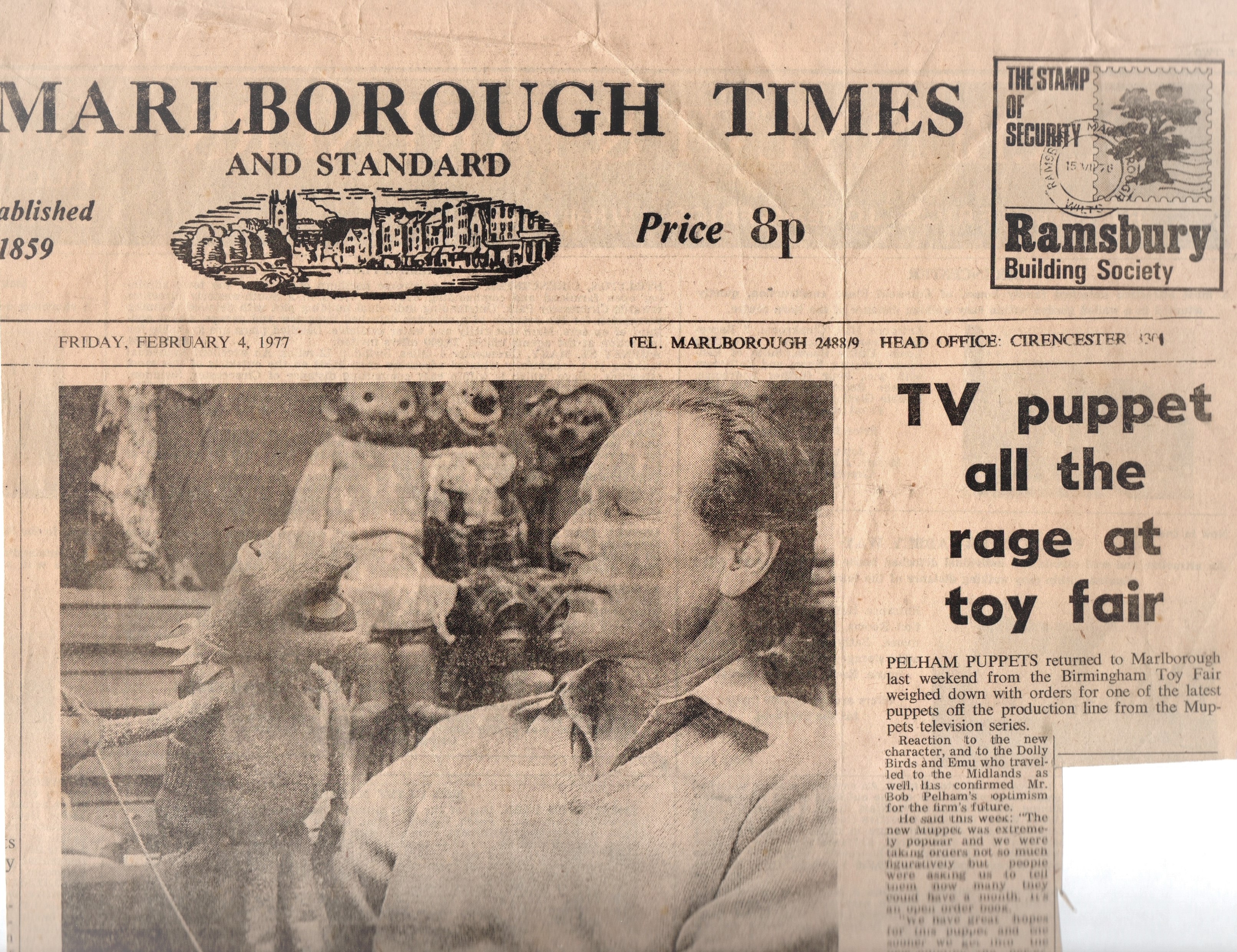 “TV Puppet all the rage at the Toy Fair” was the headline of the Marlborough Times dated February 4th, 1977. “Pelham Puppets returned to Marlborough from the Birmingham Toy Fair weighed down with orders for one of the latest puppets off the production lines from the Muppet television series. Reaction to the new character has confirmed Mr Bob Pelham’s optimism for the firm’s future.” Dominating the front page of the newspaper was a photograph of Bob Pelham with his hand operated puppet of Kermit The article continued, “The new puppet was extremely popular and we were taking orders not so much figuratively but people were asking us to tell them how many they could have a month, it’s an open order book.”
“TV Puppet all the rage at the Toy Fair” was the headline of the Marlborough Times dated February 4th, 1977. “Pelham Puppets returned to Marlborough from the Birmingham Toy Fair weighed down with orders for one of the latest puppets off the production lines from the Muppet television series. Reaction to the new character has confirmed Mr Bob Pelham’s optimism for the firm’s future.” Dominating the front page of the newspaper was a photograph of Bob Pelham with his hand operated puppet of Kermit The article continued, “The new puppet was extremely popular and we were taking orders not so much figuratively but people were asking us to tell them how many they could have a month, it’s an open order book.”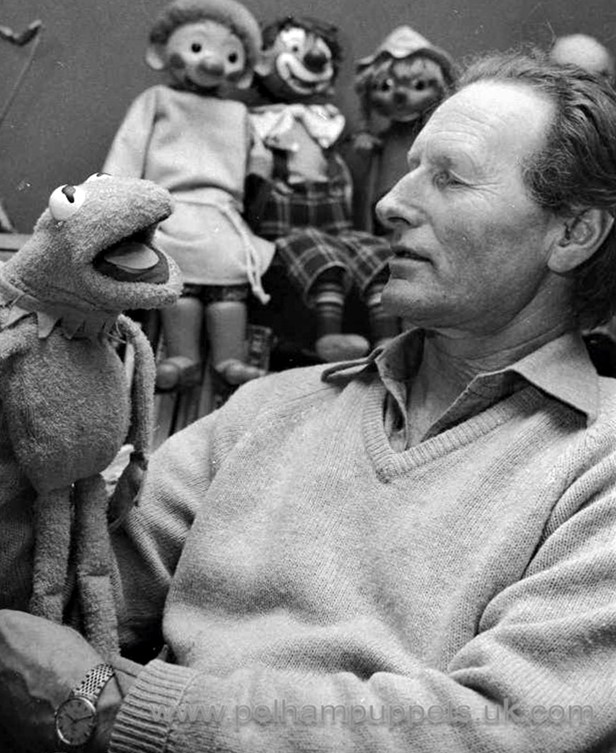 Originally, Bob had intended to produce Kermit as a hand puppet. However, it seemed that it might look too much like other soft toys on the market at the time so string puppets were made of Kermit, Miss Piggy, Rolf, Animal and Fozzy Bear. For the rest of the year, Bob was to be seen working on the prototypes, but Christmas came and went and no Muppet characters were put into production. Bob was very disappointed and it was another year before the first Muppet character, ‘Animal’ was put into production and another two years before Kermit appeared.
Originally, Bob had intended to produce Kermit as a hand puppet. However, it seemed that it might look too much like other soft toys on the market at the time so string puppets were made of Kermit, Miss Piggy, Rolf, Animal and Fozzy Bear. For the rest of the year, Bob was to be seen working on the prototypes, but Christmas came and went and no Muppet characters were put into production. Bob was very disappointed and it was another year before the first Muppet character, ‘Animal’ was put into production and another two years before Kermit appeared.
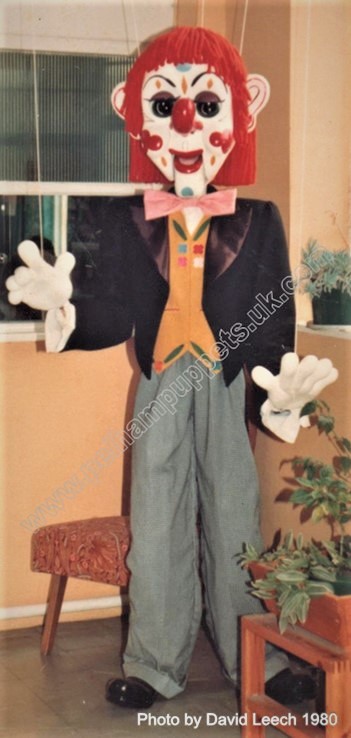 In May 1980, after discussing the deteriorating situation with his accountants and financial advisers, Bob realised he was going to have to say ‘goodbye’ to many old and loyal friends. On May 21st he gathered the entire workforce together to explain the situation and the steps that had to be taken to ensure the continuation of the business. Thirty people were to lose their jobs but there was no alternative.
In May 1980, after discussing the deteriorating situation with his accountants and financial advisers, Bob realised he was going to have to say ‘goodbye’ to many old and loyal friends. On May 21st he gathered the entire workforce together to explain the situation and the steps that had to be taken to ensure the continuation of the business. Thirty people were to lose their jobs but there was no alternative. 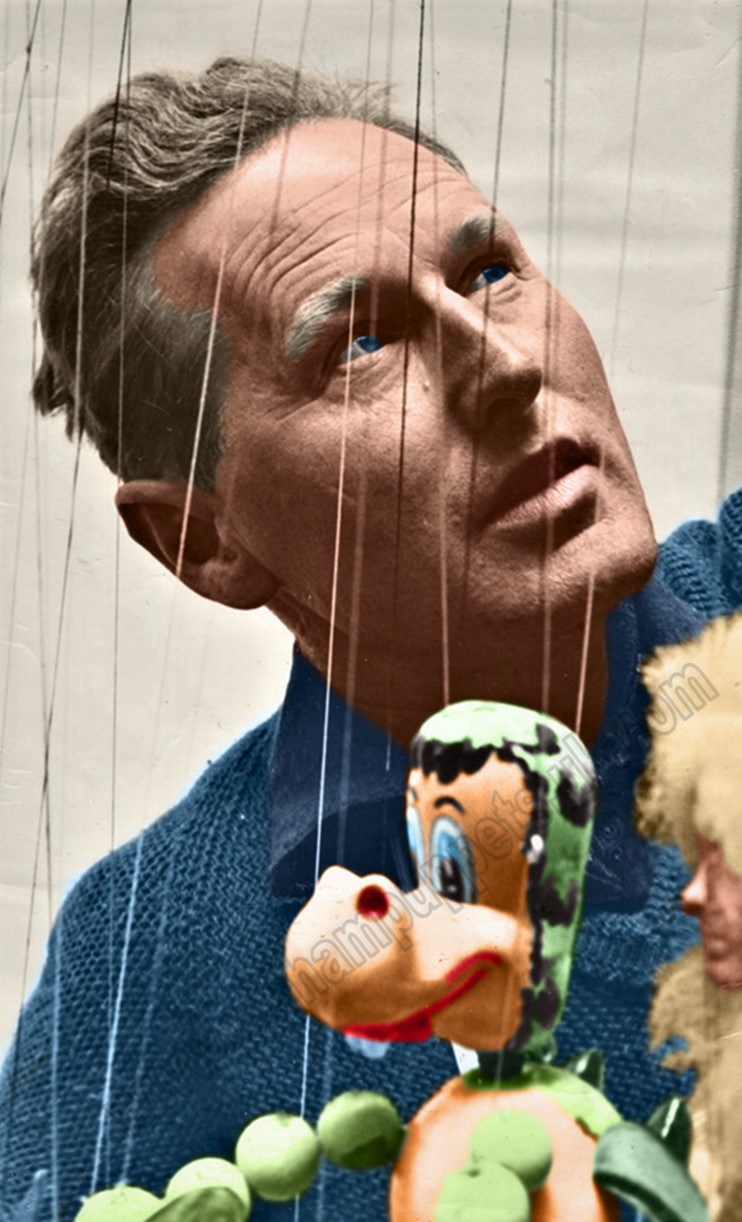 Though ‘PELPOP’ was gone the puppets remained, no less alive than they had ever been. A couple of years later, in 1982 Anne Pelham put the position clearly before all her agents and exhorted them to find new customers and to encourage the old ones. They took up the challenge and went out to see what they could do. However in spite of the Director’s efforts to keep the company going, they issued a statement to the local press explaining that the company was producing more puppets than they were selling and from August over sixty of the remaining employees were to be made redundant. In addition, the land and factory buildings north of the River Kennet were to be disposed of either by letting or selling. The company struggled on for another four years but in January 1986, Anne announced that she was calling in administrators to wind up the business and sell the company. On April 4th, 1986 production ceased at the London Road factory and forty years of Pelham Puppets ended abruptly.
Though ‘PELPOP’ was gone the puppets remained, no less alive than they had ever been. A couple of years later, in 1982 Anne Pelham put the position clearly before all her agents and exhorted them to find new customers and to encourage the old ones. They took up the challenge and went out to see what they could do. However in spite of the Director’s efforts to keep the company going, they issued a statement to the local press explaining that the company was producing more puppets than they were selling and from August over sixty of the remaining employees were to be made redundant. In addition, the land and factory buildings north of the River Kennet were to be disposed of either by letting or selling. The company struggled on for another four years but in January 1986, Anne announced that she was calling in administrators to wind up the business and sell the company. On April 4th, 1986 production ceased at the London Road factory and forty years of Pelham Puppets ended abruptly.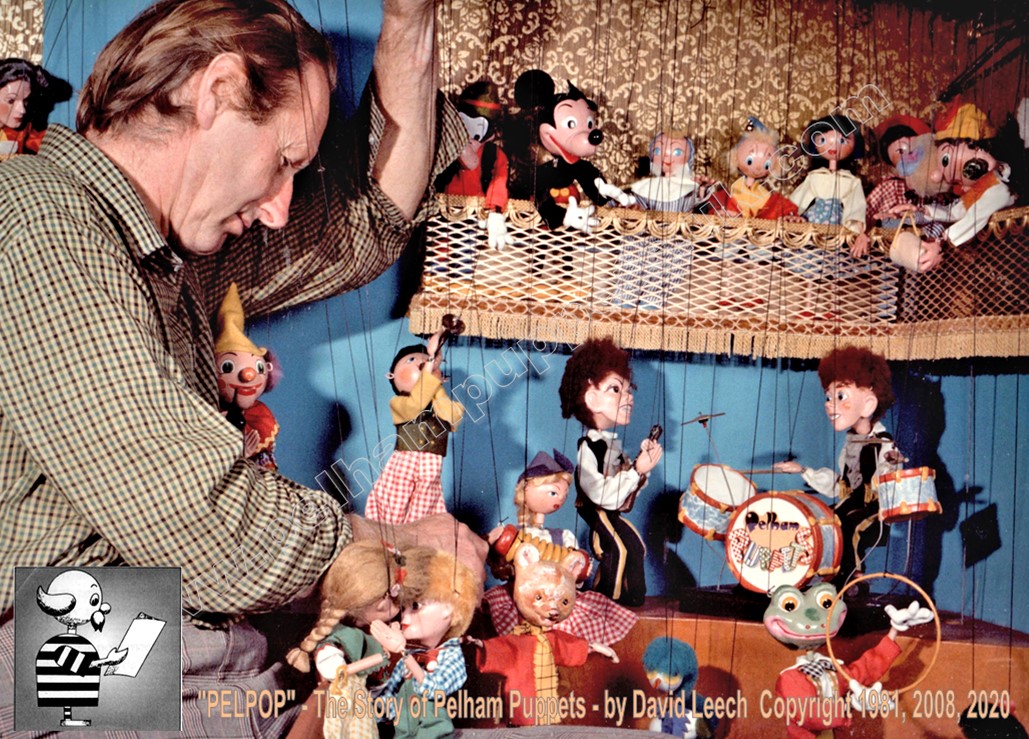





 They immediately telephoned the fire brigade and then called Bob to tell him what was happening. Bob was thinking about going to bed but rapidly changed his mind! He telephoned Frank Lawton who lived a few hundred yards away in the same village, Ogbourne St Andrew. By the time he had done this, Anne, who was upstairs could see the red glow of the fire lighting up the sky in Marlborough about three miles away. The fire had obviously got a good hold by now and the concern was which part of the factory was actually on fire. Upon arriving at the scene Bob’s worse fears were confirmed, it was the paint shop that was ablaze in the centre of the factory. This explained the intensity of the heat and the rapid way in which it had spread. There was also the alarming sound of paint pots exploding periodically as the heat reached them. Each drum of paint that went up fed the flames to greater intensity and helped to spread the fire over the surrounding area.
They immediately telephoned the fire brigade and then called Bob to tell him what was happening. Bob was thinking about going to bed but rapidly changed his mind! He telephoned Frank Lawton who lived a few hundred yards away in the same village, Ogbourne St Andrew. By the time he had done this, Anne, who was upstairs could see the red glow of the fire lighting up the sky in Marlborough about three miles away. The fire had obviously got a good hold by now and the concern was which part of the factory was actually on fire. Upon arriving at the scene Bob’s worse fears were confirmed, it was the paint shop that was ablaze in the centre of the factory. This explained the intensity of the heat and the rapid way in which it had spread. There was also the alarming sound of paint pots exploding periodically as the heat reached them. Each drum of paint that went up fed the flames to greater intensity and helped to spread the fire over the surrounding area. Characteristically, Bob turned his attention to the houses immediately across the road from the factory which were thatch covered and toward which the wind was blowing the flames and sparks. Leaving his own problems for the moment, Bob set about organising a party to keep the thatch of the roofs damped down. That done, he turned his attention back to his own problems which were becoming increasingly serious as every single minute passed. How much were they going to be able to save? Bob and Frank and a number of others immediately ran to the stock room which was piled high with completed goods. Frantically they began passing these out through the window to other willing hands who quickly formed a chain to move as much as possible out of reach of the flames. Bob was however, soon presented with another danger. The water being pumped into the upper floor was soaking through the ceiling above him and it was now beginning to collapse. Working against time, Bob and his helpers snatched what they could from the stock room but finally had to leave by order of the fire brigade.
Characteristically, Bob turned his attention to the houses immediately across the road from the factory which were thatch covered and toward which the wind was blowing the flames and sparks. Leaving his own problems for the moment, Bob set about organising a party to keep the thatch of the roofs damped down. That done, he turned his attention back to his own problems which were becoming increasingly serious as every single minute passed. How much were they going to be able to save? Bob and Frank and a number of others immediately ran to the stock room which was piled high with completed goods. Frantically they began passing these out through the window to other willing hands who quickly formed a chain to move as much as possible out of reach of the flames. Bob was however, soon presented with another danger. The water being pumped into the upper floor was soaking through the ceiling above him and it was now beginning to collapse. Working against time, Bob and his helpers snatched what they could from the stock room but finally had to leave by order of the fire brigade. John and Ann Fraser were both employed at Pelham Puppets at the time of the fire. John worked in the maintenance workshop and Ann worked there for 17 years, mainly in the moulding room. Ann recalls, “I remember that night, John had been out with his friends and he came home later than expected and told us about the fire. He was absolutely black from head to foot with soot since he’d gone down to try and help out where he could. Before he left to come home that night Mr Pelham saw him and said, “John, you have ruined your best suit.” John told Mr Pelham not to worry about that since there was a lot of work to do in trying to save the stock and put the fire out. The next morning, Mr Pelham gave him some money to buy a new suit – I remember that!” John was over the moon! He was one of the best people I have ever worked for, he really was.
John and Ann Fraser were both employed at Pelham Puppets at the time of the fire. John worked in the maintenance workshop and Ann worked there for 17 years, mainly in the moulding room. Ann recalls, “I remember that night, John had been out with his friends and he came home later than expected and told us about the fire. He was absolutely black from head to foot with soot since he’d gone down to try and help out where he could. Before he left to come home that night Mr Pelham saw him and said, “John, you have ruined your best suit.” John told Mr Pelham not to worry about that since there was a lot of work to do in trying to save the stock and put the fire out. The next morning, Mr Pelham gave him some money to buy a new suit – I remember that!” John was over the moon! He was one of the best people I have ever worked for, he really was.





 On 22nd February 1962, Harry Corbett and his wife Marjorie along with his teddy-bear puppet, Sooty, paid a visit to the Pelham Puppet factory and the ‘Prime Minister of the Marionette World’ because they wanted some marionettes simple enough for Sooty to operate on his TV show. On his tour of the factory, Harry collected an assortment of puppets including Pinky and Perky, the singing, dancing television piglets that Bob had also put into production a few years before. The Sooty Show featuring the puppets was broadcast the following month. Harry wrote to the Czech creators of Pinky and Perky, Jan and Vlasta Dalibor, seeking permission to use the characters in his show, which they readily gave and the Sooty show featuring the Pinky and Perky Pelham Puppets that was broadcast from the BBC studios in Manchester in the following month. Harry Corbett enjoyed his visit to the Pelham factory except for one thing, explained Bob, “I expect Harry wished he had his arm in a sling because he was asked to sign his autograph for every girl in the factory!”
On 22nd February 1962, Harry Corbett and his wife Marjorie along with his teddy-bear puppet, Sooty, paid a visit to the Pelham Puppet factory and the ‘Prime Minister of the Marionette World’ because they wanted some marionettes simple enough for Sooty to operate on his TV show. On his tour of the factory, Harry collected an assortment of puppets including Pinky and Perky, the singing, dancing television piglets that Bob had also put into production a few years before. The Sooty Show featuring the puppets was broadcast the following month. Harry wrote to the Czech creators of Pinky and Perky, Jan and Vlasta Dalibor, seeking permission to use the characters in his show, which they readily gave and the Sooty show featuring the Pinky and Perky Pelham Puppets that was broadcast from the BBC studios in Manchester in the following month. Harry Corbett enjoyed his visit to the Pelham factory except for one thing, explained Bob, “I expect Harry wished he had his arm in a sling because he was asked to sign his autograph for every girl in the factory!” Bob had previously arranged for Jan and Vlasta Dalibor to visit the factory to obtain first-hand information about Pinky and Perky. These two little piglets with their speeded-up voices, first appeared on BBC TV in 1957. Unlike some of the other TV characters produced under licence by the company, the Pinky and Perky Pelham Puppets proved remarkably popular and remained in production until 1985.
Bob had previously arranged for Jan and Vlasta Dalibor to visit the factory to obtain first-hand information about Pinky and Perky. These two little piglets with their speeded-up voices, first appeared on BBC TV in 1957. Unlike some of the other TV characters produced under licence by the company, the Pinky and Perky Pelham Puppets proved remarkably popular and remained in production until 1985. In 1963, over 226, 200 puppets were produced making it a record year for the number of puppets made and included a whole new range of characters designed by Peter Carter-Page. He was a respected Canadian artist who had previously worked for the Walt Disney Studios. He had been living in Toronto, Canada, before coming to England and obtained work making puppets for Jan Bussell and later began to work for Bob Pelham. More information can be found
In 1963, over 226, 200 puppets were produced making it a record year for the number of puppets made and included a whole new range of characters designed by Peter Carter-Page. He was a respected Canadian artist who had previously worked for the Walt Disney Studios. He had been living in Toronto, Canada, before coming to England and obtained work making puppets for Jan Bussell and later began to work for Bob Pelham. More information can be found  Always on the lookout for new ideas, Bob realised the fun and potential that a puppet pop group could provide. Noting the success of the Pinky and Perky TV programmes and the popularity of the music which came to dominate their shows, particularly with a group of puppets called the ‘Beakles’ which as their name implied, consisted of a ‘fab four’ with huge beak faces, Bob came up with a pop group of his own which he called the Pelpoppets that he featured in Pelpup News and wrote: “They are not meant to look like any one particular group, they are just present-day types that can be grouped together as you please.”
Always on the lookout for new ideas, Bob realised the fun and potential that a puppet pop group could provide. Noting the success of the Pinky and Perky TV programmes and the popularity of the music which came to dominate their shows, particularly with a group of puppets called the ‘Beakles’ which as their name implied, consisted of a ‘fab four’ with huge beak faces, Bob came up with a pop group of his own which he called the Pelpoppets that he featured in Pelpup News and wrote: “They are not meant to look like any one particular group, they are just present-day types that can be grouped together as you please.”

 Above: 4-page sales leaflet depicting the reduced range of characters produced two years earlier and the introduction of the Type SM Boy and Girl. The type SM Girl had bare feet just like UK pop singer, Sandie Shaw used to do when she sang on stage.
Above: 4-page sales leaflet depicting the reduced range of characters produced two years earlier and the introduction of the Type SM Boy and Girl. The type SM Girl had bare feet just like UK pop singer, Sandie Shaw used to do when she sang on stage. Bob still managed to keep an eye on children’s television programmes and in 1965, The Magic Roundabout, created by Frenchman Serge Danot was first shown. Since rod puppets were used 90% more often in the amateur and professional shows in European countries than marionettes, Bob branched out into this style of puppet with the Magic Roundabout characters, producing rather large rod puppets of Mr Rusty, Florence, Zebedee and Florence. M Serge Danot visited the factory early in 1967 and was very impressed with what he saw and was confident that Bob would do a very good job of producing the puppet characters.
Bob still managed to keep an eye on children’s television programmes and in 1965, The Magic Roundabout, created by Frenchman Serge Danot was first shown. Since rod puppets were used 90% more often in the amateur and professional shows in European countries than marionettes, Bob branched out into this style of puppet with the Magic Roundabout characters, producing rather large rod puppets of Mr Rusty, Florence, Zebedee and Florence. M Serge Danot visited the factory early in 1967 and was very impressed with what he saw and was confident that Bob would do a very good job of producing the puppet characters. 
 Bob related how Serge Danot had been amazed at how large the puppet factory was. “I think he thought I was one man with a dog!” chuckled Bob, since Dougal, one of the most popular characters in the programme was based on a breed of dog called Shih Tzu, (pronounced Sheed Zoo) and Bob actually owned one! A black one with white paws and chest, who served to inspire the creation of the Mrs Dougal puppet, “It’s comical to see him scuttle about and twist round just like Dougal does on TV,” (The family photo shows Anne Pelham with their Shih Tzu around 1966.)
Bob related how Serge Danot had been amazed at how large the puppet factory was. “I think he thought I was one man with a dog!” chuckled Bob, since Dougal, one of the most popular characters in the programme was based on a breed of dog called Shih Tzu, (pronounced Sheed Zoo) and Bob actually owned one! A black one with white paws and chest, who served to inspire the creation of the Mrs Dougal puppet, “It’s comical to see him scuttle about and twist round just like Dougal does on TV,” (The family photo shows Anne Pelham with their Shih Tzu around 1966.)
 Bob had been working towards promoting a greater interest in puppetry from older children and grown-ups and so came up with a new range of puppets in 1968 that were designed to encourage older age groups to become involved. These were his ‘Ventriloquial Puppets’ (vent puppets for short) with large heads with flexible head movement and moving mouths. “The novelty of these new puppets is that you put your free hand through the sleeve of the jacket and the puppet now has a hand of its own,” said Bob, and “The scope they offer appeals to older children and yet their simplicity enables younger children to handle them with ease.” Within the first year, a range of seven characters, comprising of Supy, the boy with long black, sheepskin hair, Cornelia with large moving eyes and lashes, Boggles, a girl with blonde/yellow sheepskin hair, a Monk with halo attached, Katie the caterpillar also with large eyes and lashes and finally, Walter wearing the deer-stalker hat and Fido the singing dog. They became remarkably successful in the United States and consignments of five thousand at a time were exported every few weeks and, according to Bob, “Were responsible for putting our export figures up by 50% over the year.” From September 1974, legs were added to these puppets and this, in turn led to the production of 24-inch-tall string puppets in the late 70s. The upward trend continued with about one hundred thousand puppets finding their way each year, to the United States alone.
Bob had been working towards promoting a greater interest in puppetry from older children and grown-ups and so came up with a new range of puppets in 1968 that were designed to encourage older age groups to become involved. These were his ‘Ventriloquial Puppets’ (vent puppets for short) with large heads with flexible head movement and moving mouths. “The novelty of these new puppets is that you put your free hand through the sleeve of the jacket and the puppet now has a hand of its own,” said Bob, and “The scope they offer appeals to older children and yet their simplicity enables younger children to handle them with ease.” Within the first year, a range of seven characters, comprising of Supy, the boy with long black, sheepskin hair, Cornelia with large moving eyes and lashes, Boggles, a girl with blonde/yellow sheepskin hair, a Monk with halo attached, Katie the caterpillar also with large eyes and lashes and finally, Walter wearing the deer-stalker hat and Fido the singing dog. They became remarkably successful in the United States and consignments of five thousand at a time were exported every few weeks and, according to Bob, “Were responsible for putting our export figures up by 50% over the year.” From September 1974, legs were added to these puppets and this, in turn led to the production of 24-inch-tall string puppets in the late 70s. The upward trend continued with about one hundred thousand puppets finding their way each year, to the United States alone.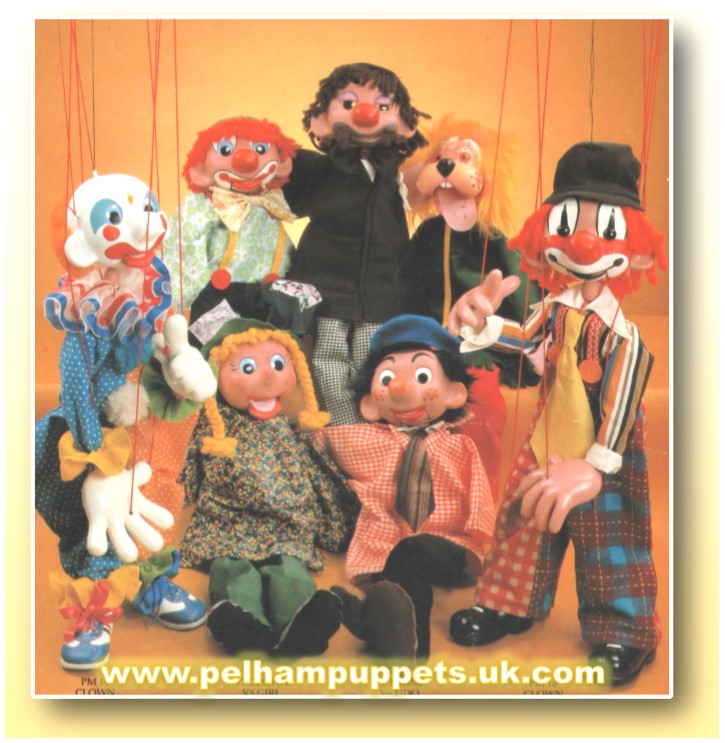
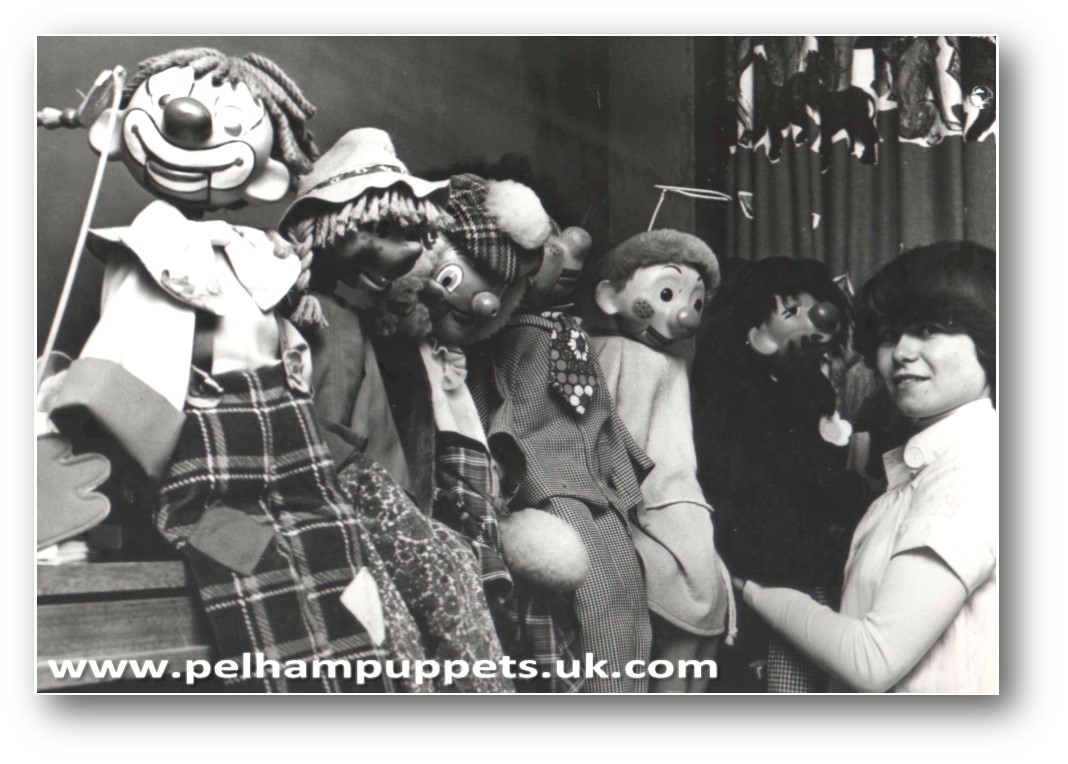

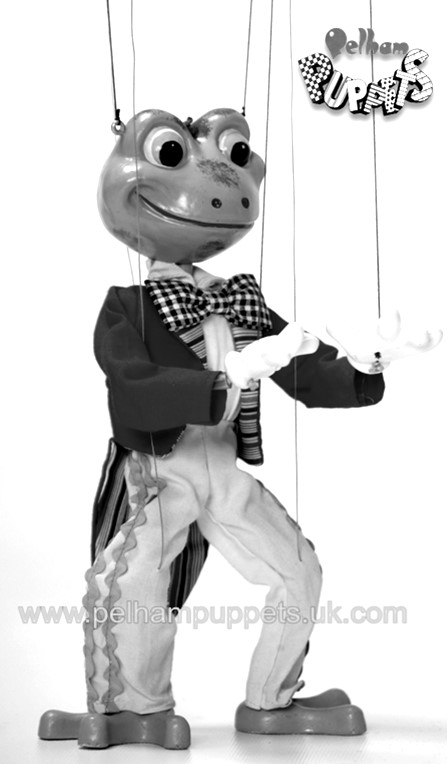 1971 saw an annual peak in production of almost five thousand puppets produced every week throughout the year, a total that exceeded a quarter million puppets.
1971 saw an annual peak in production of almost five thousand puppets produced every week throughout the year, a total that exceeded a quarter million puppets.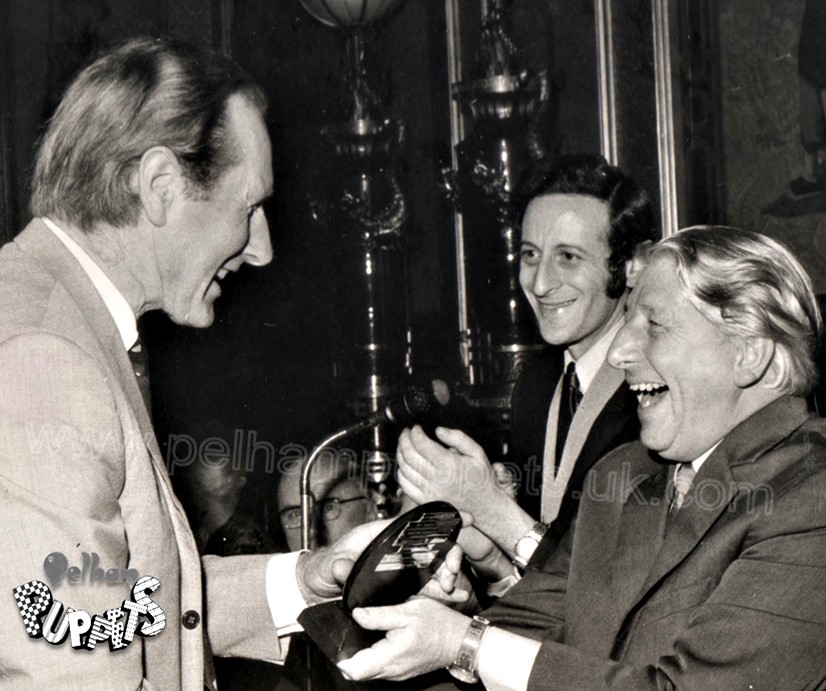 It was a very rewarding year for Bob in other ways too. His SL-type Frog had been elected Toy of the Year in France by Elle magazine, where over one hundred shops stocked the puppets. One award was quickly followed by another. The National Association of Toy Retailers awarded Bob, at their annual conference in Brighton, the silver trophy for ‘The unique and High Quality Product of World-wide Appeal and Reputation’ for his puppets generally. When Bob received the Invitation to attend the conference, he had no idea what was going to happen, so it came as a great surprise to receive the award. As he recalled, “You could have knocked me down with a feather! It was a great honour and we were all delighted.” He was presented with the award by TV personality, Johnny Morris.
It was a very rewarding year for Bob in other ways too. His SL-type Frog had been elected Toy of the Year in France by Elle magazine, where over one hundred shops stocked the puppets. One award was quickly followed by another. The National Association of Toy Retailers awarded Bob, at their annual conference in Brighton, the silver trophy for ‘The unique and High Quality Product of World-wide Appeal and Reputation’ for his puppets generally. When Bob received the Invitation to attend the conference, he had no idea what was going to happen, so it came as a great surprise to receive the award. As he recalled, “You could have knocked me down with a feather! It was a great honour and we were all delighted.” He was presented with the award by TV personality, Johnny Morris.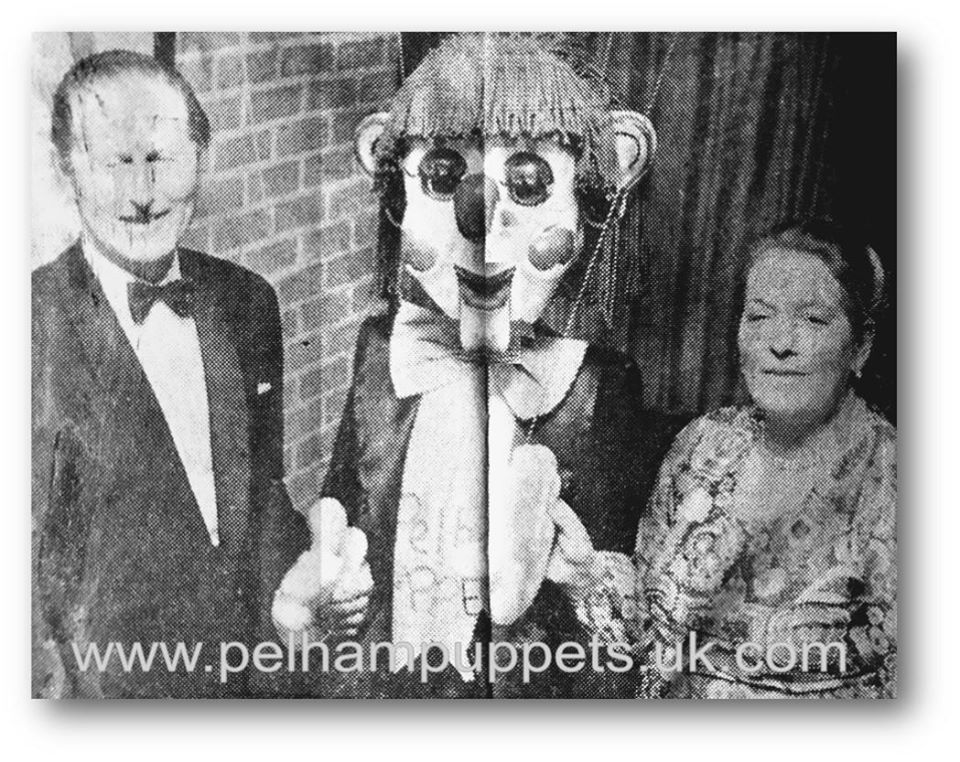
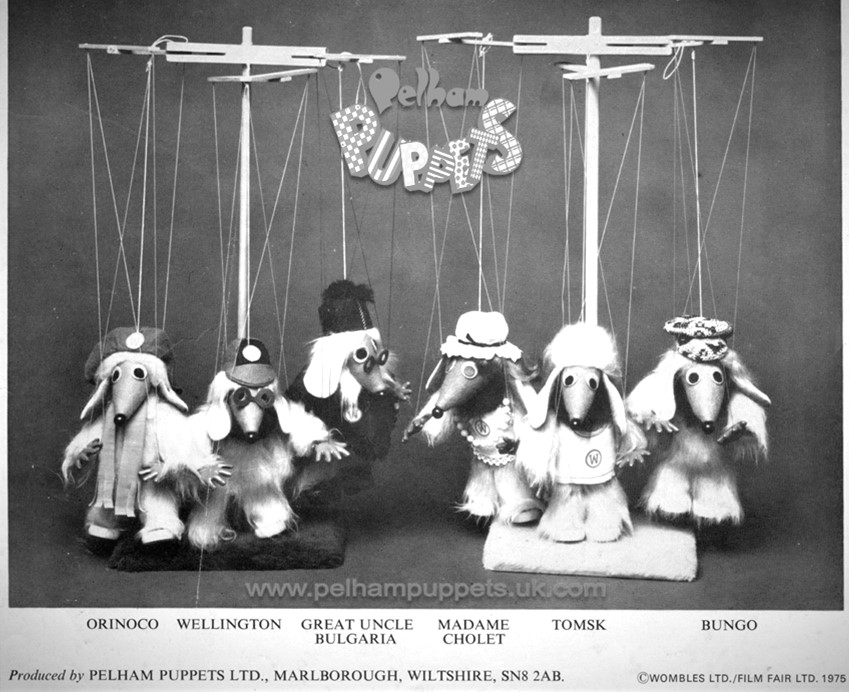 There were seven main characters in the first television series and ten characters included in the second series. However, Bob only produced a range of six characters, Great Uncle Bulgaria, Bungo, Orinoco, Madam Cholet, Tomsk and Wellington. It is not known why Tobermory was not included in the range, but he was guided by the popularity and the demand for certain characters from his buyers and the retailers, or it could simply have been due to the pressure to produce what characters they did have. Bob described 1975 as the ‘Year of the Womble’ and the year finished with a considerable increase in production, with the following year, 1976 producing an all time record year with a turnover of over half a million pounds for the first time in the company’s history.
There were seven main characters in the first television series and ten characters included in the second series. However, Bob only produced a range of six characters, Great Uncle Bulgaria, Bungo, Orinoco, Madam Cholet, Tomsk and Wellington. It is not known why Tobermory was not included in the range, but he was guided by the popularity and the demand for certain characters from his buyers and the retailers, or it could simply have been due to the pressure to produce what characters they did have. Bob described 1975 as the ‘Year of the Womble’ and the year finished with a considerable increase in production, with the following year, 1976 producing an all time record year with a turnover of over half a million pounds for the first time in the company’s history.

